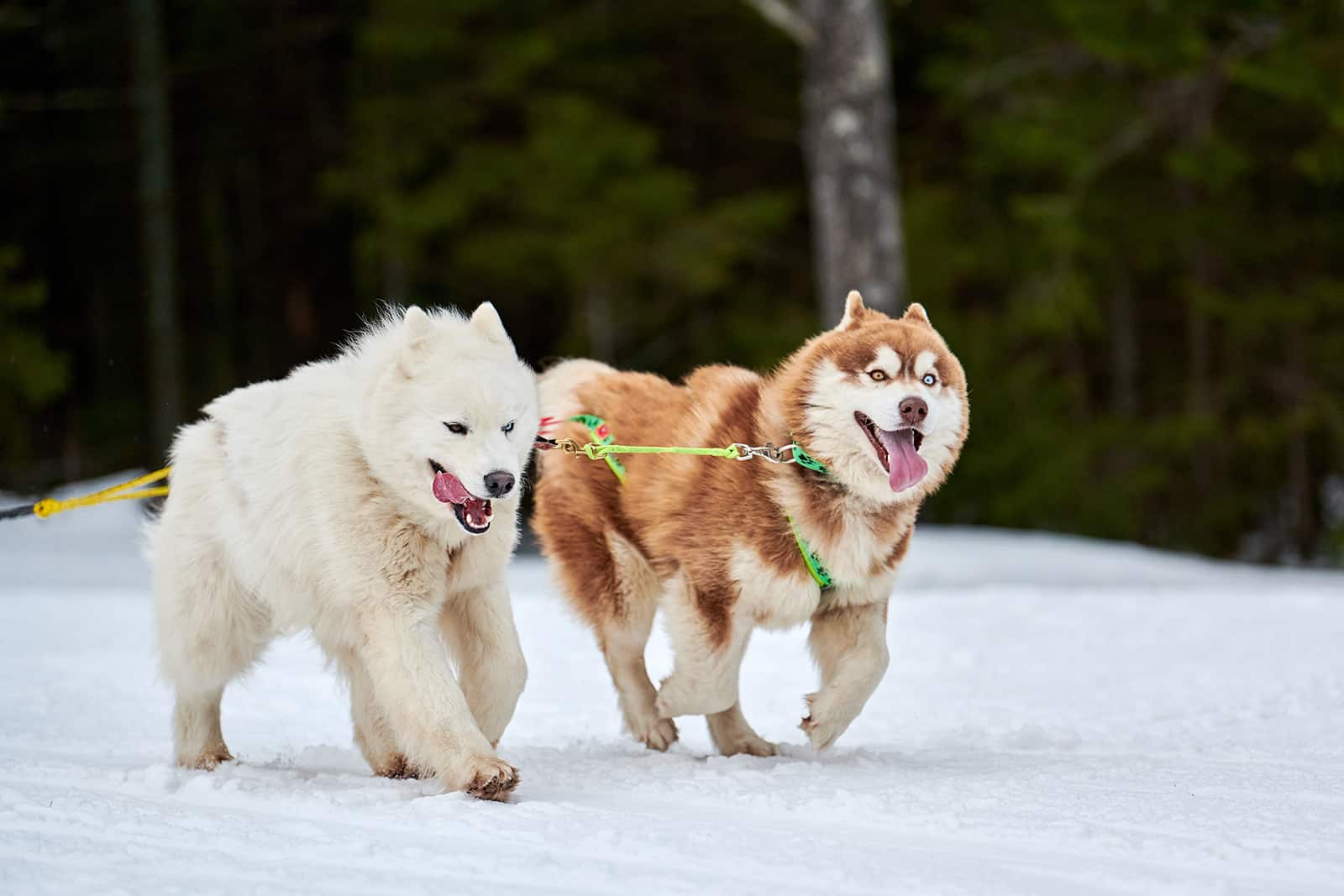The world is yet to be introduced to some pawmazing Russian dogs.
We’re used to seeing popular breeds like Golden Retrievers and German Shepherds all over the world. But, not many people know about the Volkosob or the Caucasian Shepherd.
Sure, Samoyeds and Huskies are widely-known, but their other friends deserve the same level of attention.
Let’s see what Russia and the foreign Soviet Union have to offer us. What kind of dog breeds have they produced and what are they proud of?
1. Siberian Husky
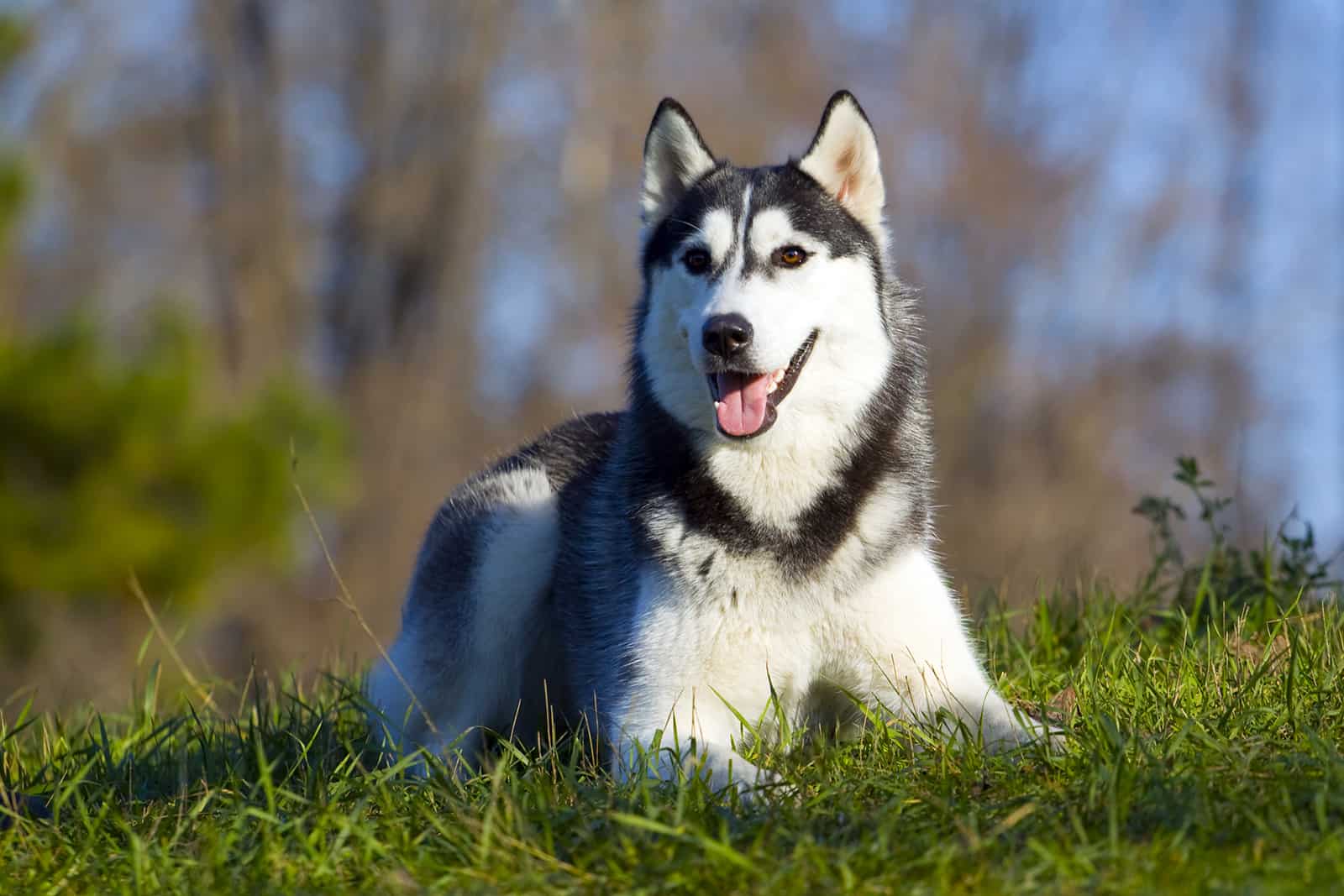
Background story
The most popular of all the Russian dogs is definitely the Siberian Husky.
Originally from the ice-cold and snowy part of Russia, Siberia, the Siberian Husky has come a long way since its sled-pulling days in the Chukchi tribe, some 4,000 years ago.
Today, they’re popular family pets and companions that occasionally enjoy playing as sled dogs.
Those Huskies that are still living in Siberia are valued members of the community. They guard people and their properties and aid them with transportation in the snow.
Appearance
Siberian Huskies are blessed with a wonderful, dense coat that keeps them extra warm during cold days and nights.
As you can imagine, these dogs don’t do well in hot climates, and bathing them won’t help since our Siberian buddy should not be bathed that often. Huskies come in all sorts of colors, from standard gray shades to brown Huskies and white ones.
Sadly, Husky coats shed quite a lot, so invest in a good brush for your Husky. Otherwise, you’ll be covered in dog hair so much that you will be able to make a whole new Husky out of it!
What will truly mesmerize you about this Russian dog is the fact Husky eyes feature gorgeous colors. Some even have eyes of different colors, a condition called heterochromia,
Temperament
Both Husky boys and girls are sweet pups, not aggressive at all. However, I have to warn you about their stubbornness.
You might have a hard time training your Husky, especially teaching him not to bark too much. Also, a Husky‘s howling can‘t be controlled. But, that simply grows on you, eventually.
2. Borzoi
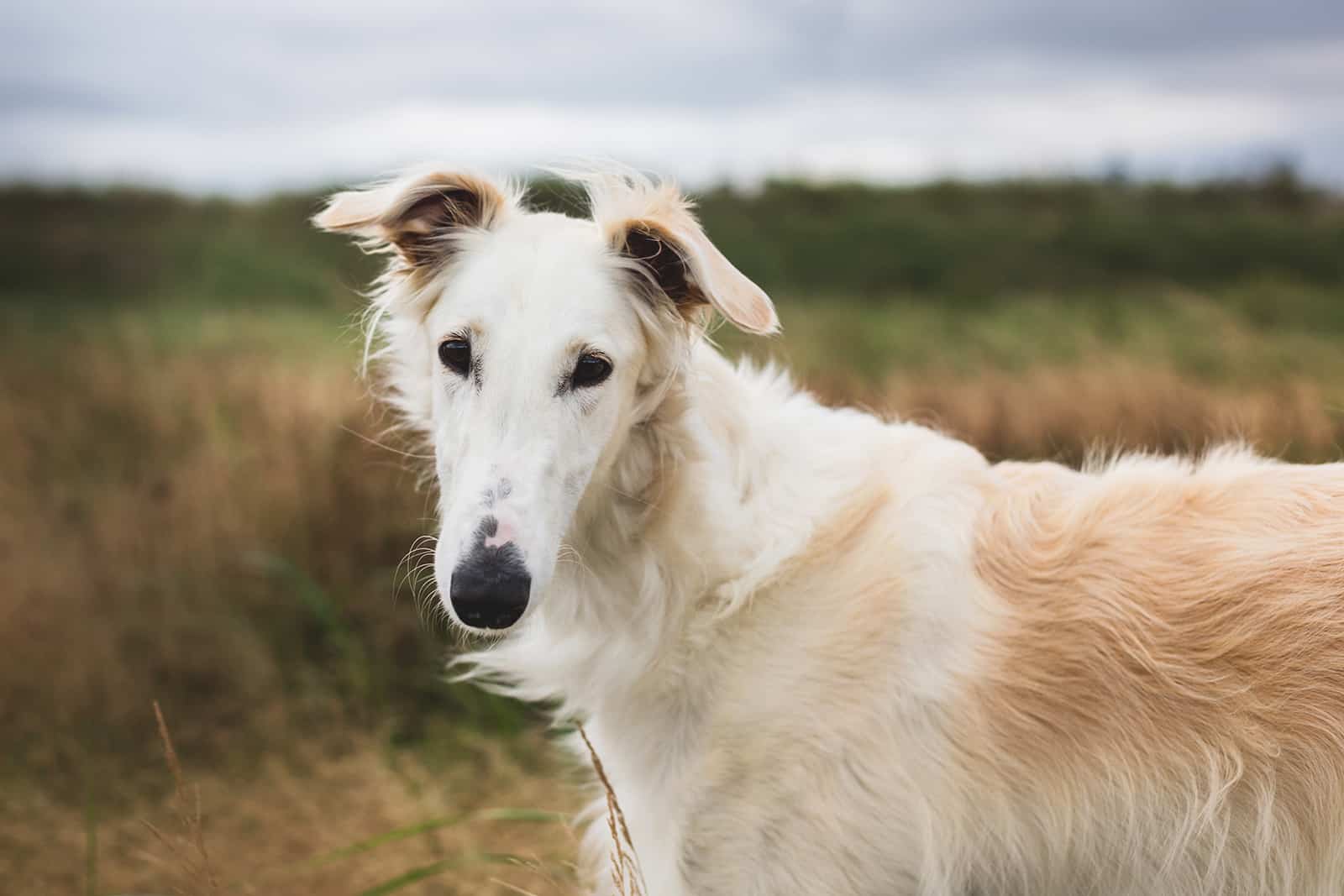
Background story
Let’s meet one of the Russian dogs with an incredibly long legacy!
The Russian Wolfhound, as these pups were once called, is actually a Borzoi. This purebred Russian dog was once a favorite of the Russian aristocracy. Nowadays, there are many reputable Borzoi breeders in the U.S. and across the globe!
There’s something special about this dog’s regal posture. I’m really not surprised why the nobility chose a Borzoi to be their companion.
Borzois are not lap dogs. They’re large dogs that have their own particular needs, which we’re about to discuss below.
Appearance
Borzois are actually sighthounds that can run at a rather spectacular speed thanks to their super-slender body, resembling a Greyhound. Borzois are, in fact, one of the world’s fastest dog breeds.
An average Borzoi will weigh up to 100 pounds. So, they’re quite heavy!
These pups usually feature a pure white coat with patches of brown. However, other coat colors are also possible in Borzois.
The first thing that you’ll notice with the Borzois are their elongated muzzles and small, round and sparkly eyes. The first time I saw a Borzo,i I thought: Why does this dog look so surprised?
And yes, they do have a somewhat surprised facial expression, but that only makes them more adorable.
Borzois are blessed with a lovely, silky, and long coat. Unfortunately, they are not hypoallergenic and they do have a tendency to shed.
Temperament
The biggest downside of a Borzois is definitely his stubbornness, which will surface during training time. Other than that, these doggos are pretty amazing.
Borzois have a calm temperament and they appreciate their family members a lot. This is a dog that will adapt easily to any lifestyle.
Experts describe the Borzoi’s behavior as feline-like. And truly, they’re graceful and calm, just like kitties!
3. Caucasian Shepherd
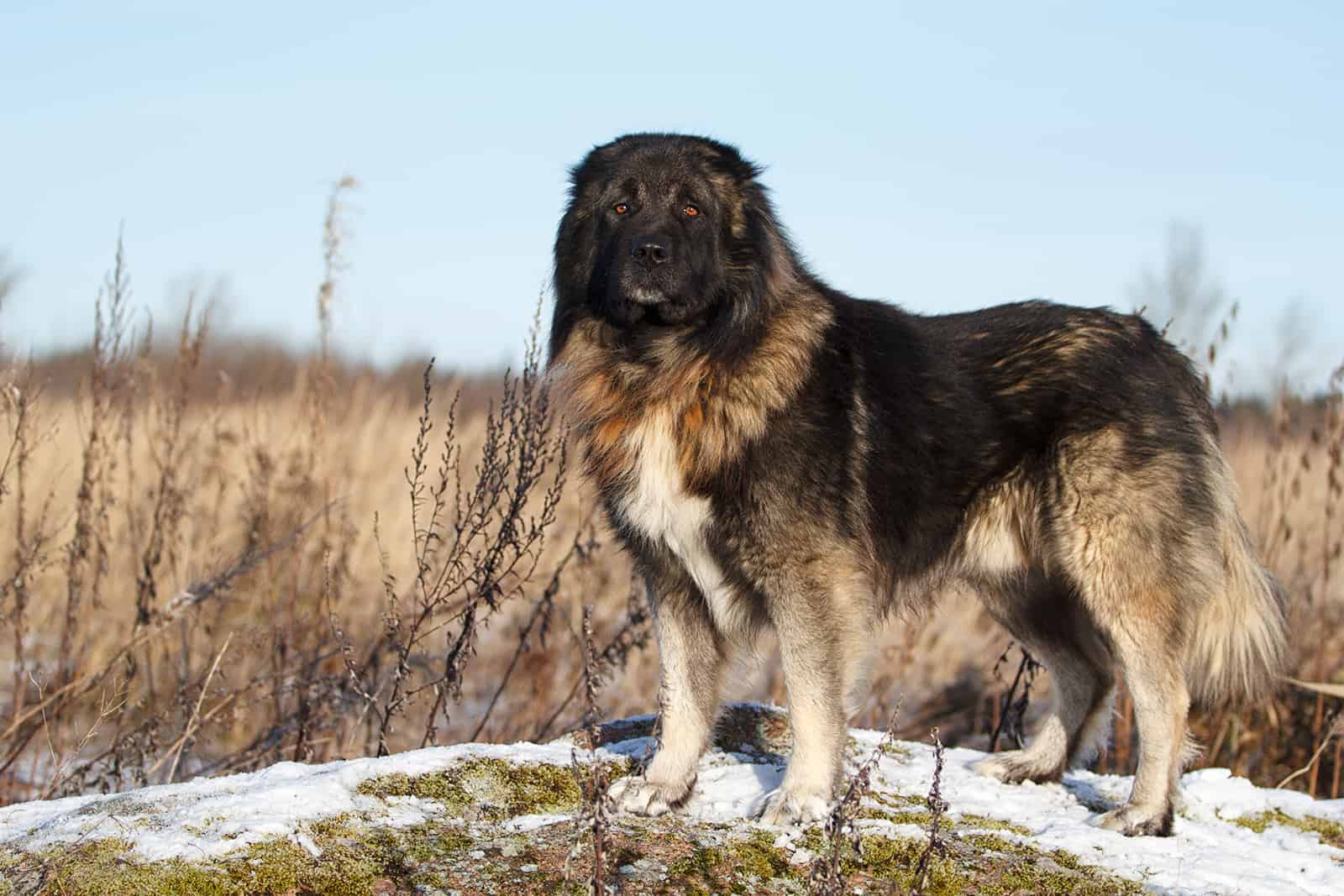
Background story
The famous Caucasus mountains in the southern part of Russia are home to one magnificent creature: the Caucasian Shepherd. You will find this Russian dog breed under another name too, the Caucasian Ovcharka.
The Caucasian Shepherd is a true shepherd-type dog like other shepherds, i.e. Australian Shepherds boys and girls. These dogs used to serve farmers for many centuries.
They have proven themselves as pawmazing herding dogs that used to keep the livestock and the farmers safe from wild animals.
Appearance
The Caucasian Shepherd will leave you astonished with their appearance. These are Mastiff-type hounds and the first thing that you’ll notice is their intimidating size.
You’ll get a better image of how big a Caucasian Shepherd is if I tell you their weight. Caucasian Ovcharka can weigh up to 170 pounds!
These are real giants, but whether they’re gentle, you’ll find that out soon.
This Russian dog has a double coat, with a feathery soft undercoat, and a longer, coarser top layer. This means you will need to spend a fair share of your time brushing your Caucasian Shepherd.
As far as their colors are concerned, Caucasian Ovcharka dogs come in six different colors, including pure white. But, that coat condition is not linked to dog albinism.
Temperament
When I mentioned how intimidating Caucasian Shepherds appear, I did not think of their temperament. Sure, strangers might feel scared around them, but that’s the whole point of having a guard dog.
Caucasian Shepherds are genuinely sweet and affectionate. They make bonds with their family members easily, so expect a lot of signs of love and respect.
I would recommend that you act dominantly around Caucasian Ovcharka dogs, since otherwise, they tend to take over situations and imprint themselves as alpha dogs of the pack.
4. Samoyed
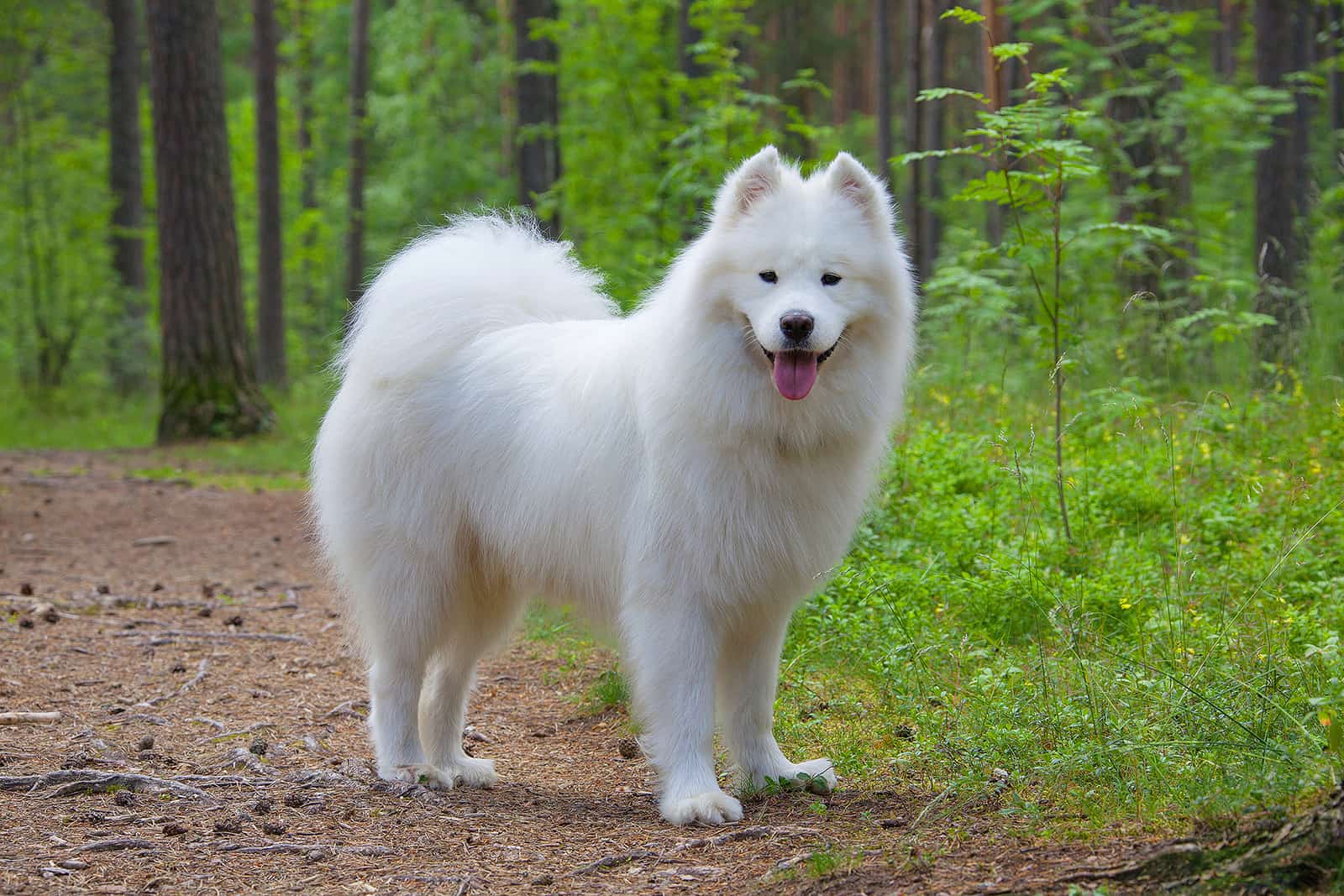
Background story
Who’d have known that one of the sweetest-looking dog breeds comes from the coldest place, not only in Russia, but in the world?
Our beloved Samoyed, or Sammie, is originally from Oymyakon, where the temperature goes so far below zero, that it’s impossible to comprehend.
The Samoyed’s signature smile is not a sign of how happy this puppy is. I mean, they’re pretty ecstatic, but their permanent grin is because of something completely different.
Samoyeds, used to living in harsh conditions, smile to prevent icicles from forming in their mouths.
How incredible is that?
Appearance
Coming from the freezing-cold conditions of Oymyakon, Samoyeds have grown a naturally thick coat. Yes, it sheds like crazy.
Their white color is there to blend with their surroundings, especially if they’re somewhere in the open, where a wild animal could come and attack these dogs and their owners.
But, Sammies also come in other coat shades. Different colors will cost more than an average Sammy usually costs.
Samoyeds look a lot like Japanese Spitz dogs, however, they’re not the same. Our Sammy boys and girls are bigger, fluffier, and simply kinder than any other dogs out there.
With their stocky build, pointy ears, and happy face, it’s impossible not to recognize a Sammy in a crowd of dogs.
Temperament
Even though you might think that these pups are always so energetic and active because of their thrilled facial expression, that’s really not the truth.
Samoyeds are calm dogs that love showing affection and taking some in return. They’re characterized by not only excellent companion skills but also their amazing work ethic.
Samoyeds were used as working dogs, and they still serve as such in some parts of the world, especially in Russia.
All in all, Sammies are sweet dogs without signs of aggression. They make good family pets. So, if you want one, check out these USA-based Samoyed breeders. If none of these work out, there are always Sammy breeders in Ontario.
5. East Siberian Laika
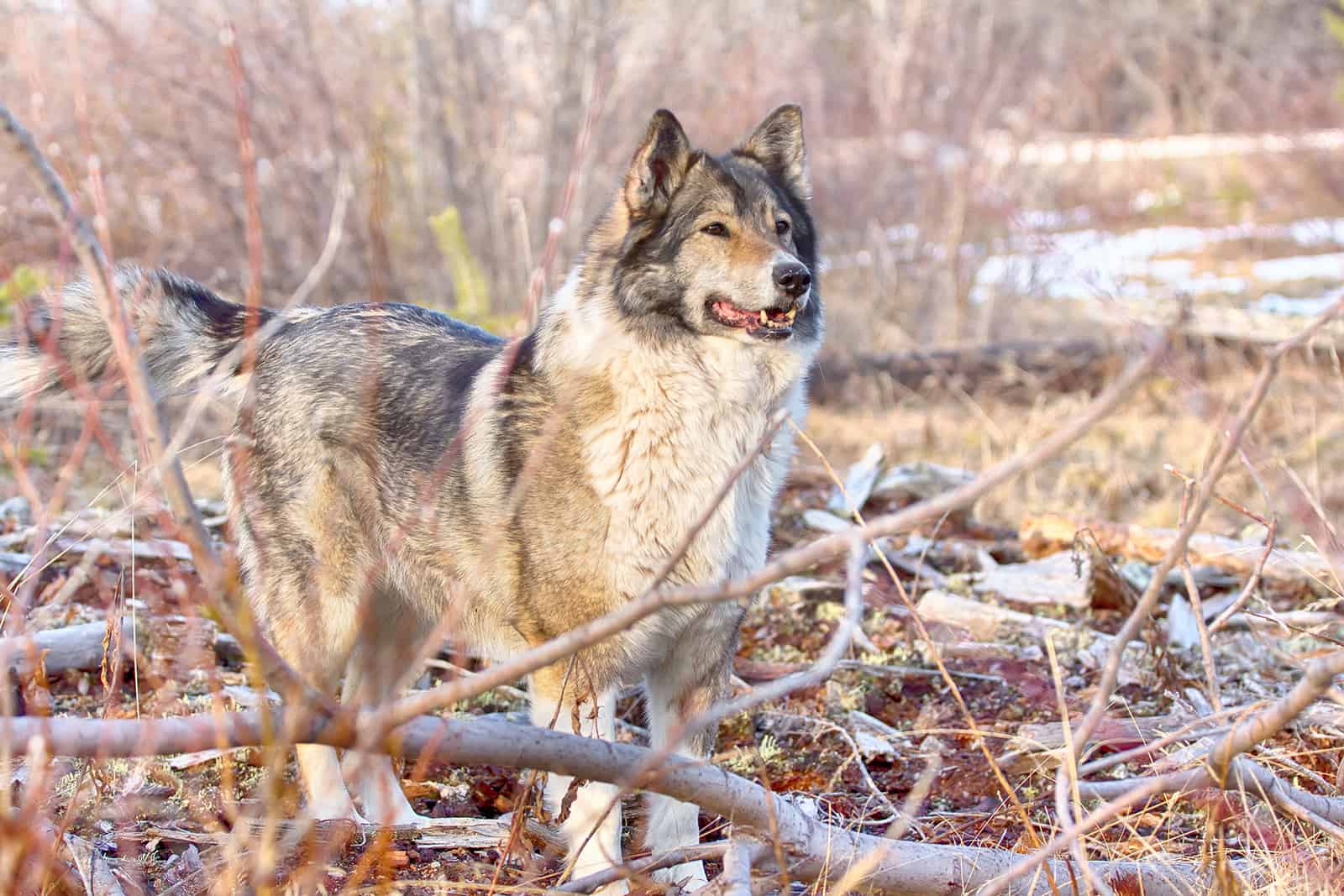
Background story
Just like the name says, the East Siberian Laika is one of those Russian dogs from Siberia. Precisely, the East Siberian Laika is from the east of the river Yenisei in Siberia.
Given the position on the map of this dog breed, it’s obvious that they had contact with other Asian dog breeds, mostly Chinese and Japanese dog breeds.
This has influenced the Laika’s appearance a lot, since she resembles the above-mentioned dog breed with her curled-up tail, pointy ears, and muzzle.
Appearance
As I just mentioned, Laikas have curled tails and pointy ears. Their body build is pretty much similar to a Husky’s. No wonder, because these two dog breeds are close relatives.
The East Siberian Laika has a breed standard that was determined in 1947. However, no major kennel clubs, like the American Kennel Club (AKC), have accepted the Laika as an official dog breed.
A Laika’s appearance still brings lots of comments. This is a spitz-like dog breed. You won’t be able to distinguish it easily from the West Siberian Laika. Both are terrific hunting dogs, which you’ll learn about in the following section.
Temperament
So, hunting dogs, huh? Since she comes from the cold Siberia, I’m not surprised Laika was used for hunting. She was always so helpful to the people in Siberia living with her, with her great hunting skills, passion, and energy.
East Siberian Laikas are not aggressive or feral in any case. They’re calm and loyal. These Laikas make excellent watchdogs since they’ll do anyything it takes to protect their family.
Of course, with dogs featuring such a strong prey drive, early socialization is a must.
If you have some luck and are able to get an East Siberian Laika, rest assured you’ll be getting a fine family dog.
6. South Russian Ovcharka
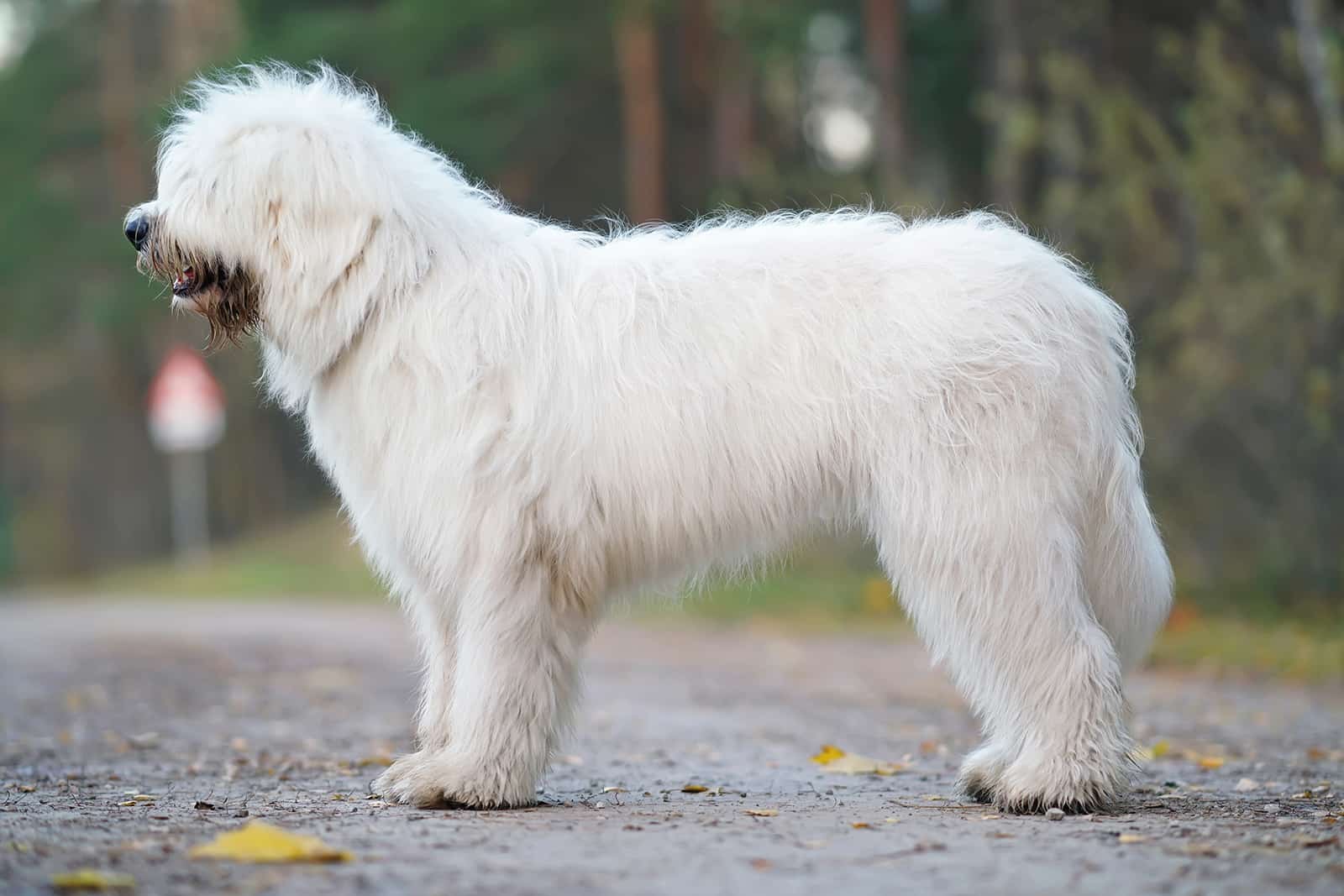
Background story
When we talk about Russian dogs, we have to mention the dog breeds that are originally from parts of the former Soviet Union. There are lots of dog breeds that came from the satellite countries that were once attached to the Soviets.
A fine example of such a dog is the South Russian Ovcharka. This is not only one of the rarest dogs you’ll see, but also a pup with an unusual appearance.
Even though her name says she’s from Russia, the South Russian Ovcharka actually has Ukrainian origins. That’s where her other name comes from, the Ukrainian Shepherd dog.
Specifically, the Ovcharka comes from a part of the land around the Azov Sea and the Black Sea.
Appearance
The Russian Ovcharka is a dog suitable for living in different temperatures, from cold winters to warm summers, despite their big, double coats.
The first thing you’ll definitely notice about these dogs is their shaggy coats, which usually come in white, cream, gray, etc. The other thing that will catch your attention is their muscular build.
The South Russian Ovcharka can grow up to weigh over 100 pounds!
An Ovcharka, if properly groomed, can have a stunning coat that naturally invites you to run your fingers through it and enjoy the softness.
Temperament
The South Russian Ovcharka is, obviously, a herding dog. However, I can’t forget about their other job, they are also good guard dogs.
This means you will need to socialize your Ovcharka because they can be prone to aggressive behavior around strangers, especially unknown dogs.
Of course, he’s protective of his family and very devoted to the people that he loves.
I do have to warn you about their possessive behavior. If you already have small animals around the house, or even little children, bringing an Ovcharka into that home might not be a good idea.
That is if you manage to find one, since this is definitely the rarest of all the Russian dogs.
7. Yakutian Laika
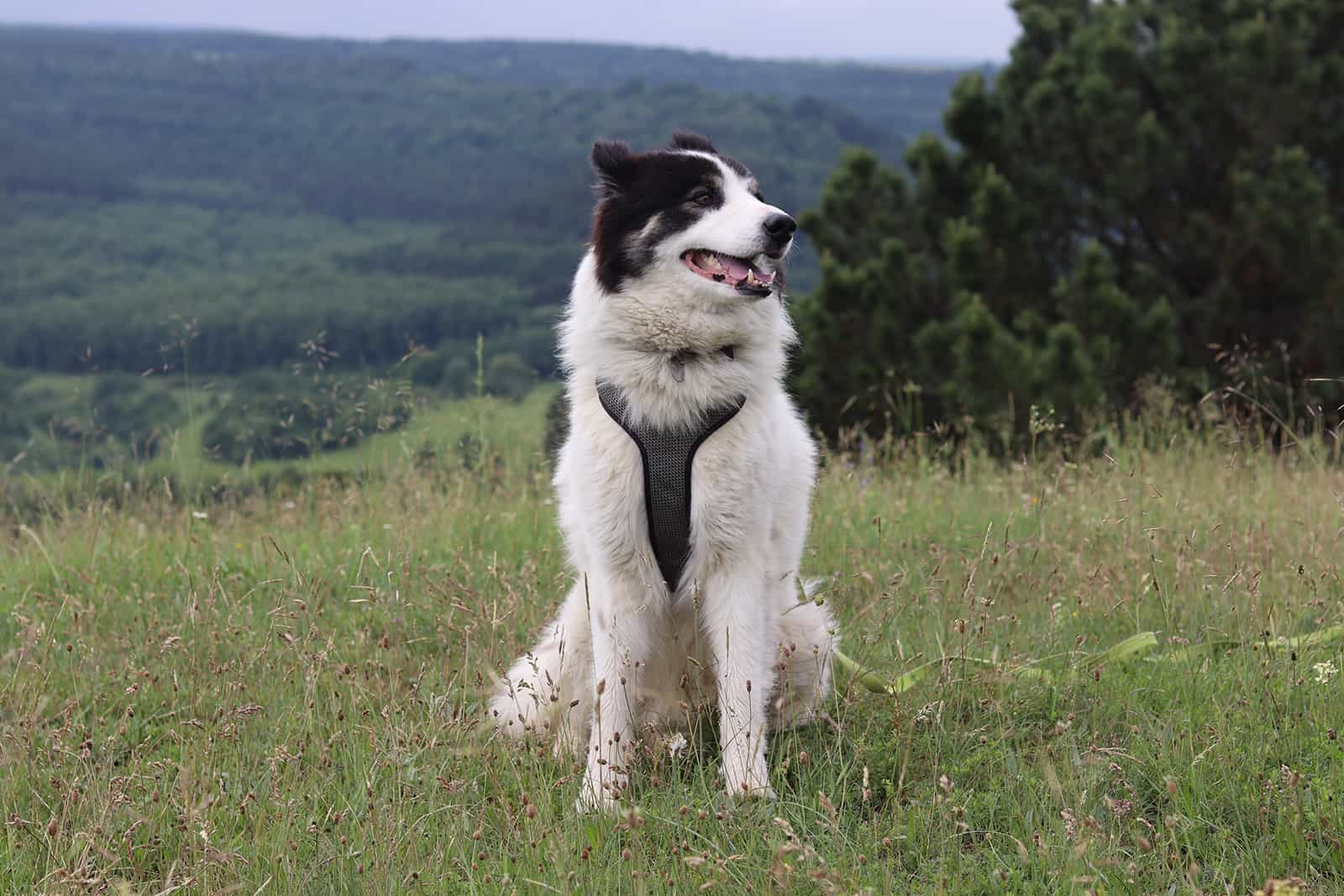
Background story
Meet one of the Russian dogs with an ancient history. Even though the Yakutian Laika is a fairly new breed, her roots date back to 12,500 years ago!
Recently, some archaeological excavations have found proof of Yakutian Laikas living with the Sakha tribe, or the Yakuts.
The Yakuts used Laikas for multiple purposes, but mostly for hunting reindeer, herding their cattle, and hauling carcasses back to their base camp. The Yakutian Laika was also used to pull sleds.
Appearance
Personally, of all the Laikas you’ll read about, this is my favorite in terms of their appearance. The Yakutian Laika features a dense double coat.
The undercoat is soft, while the top layer is coarse and often comes in black, brown, gray, and white, but also bi-color and tri-color combinations.
The black and white Yakutian Laika is especially gorgeous.
I understand why some people mistake them for Huskies, especially for wooly Huskies.
Temperament
The Yakutian Laika is an exceptionally smart canine. But their big brains weren’t the only reason why the Yakuts loved them so much. This Laika is extremely durable, and she will go through anything to satisfy her owner.
The Yakutian Laika will never leave a job half-done. I put this down to their high-energy drive. If you want this Laika, you better bring her into a big home with big, fenced yards.
A Laika will need lots of exercise, as well as proper mental stimulation.
When it comes to training them, it should be a breeze thanks to their intelligence and eagerness to please their owners.
8. East European Shepherd
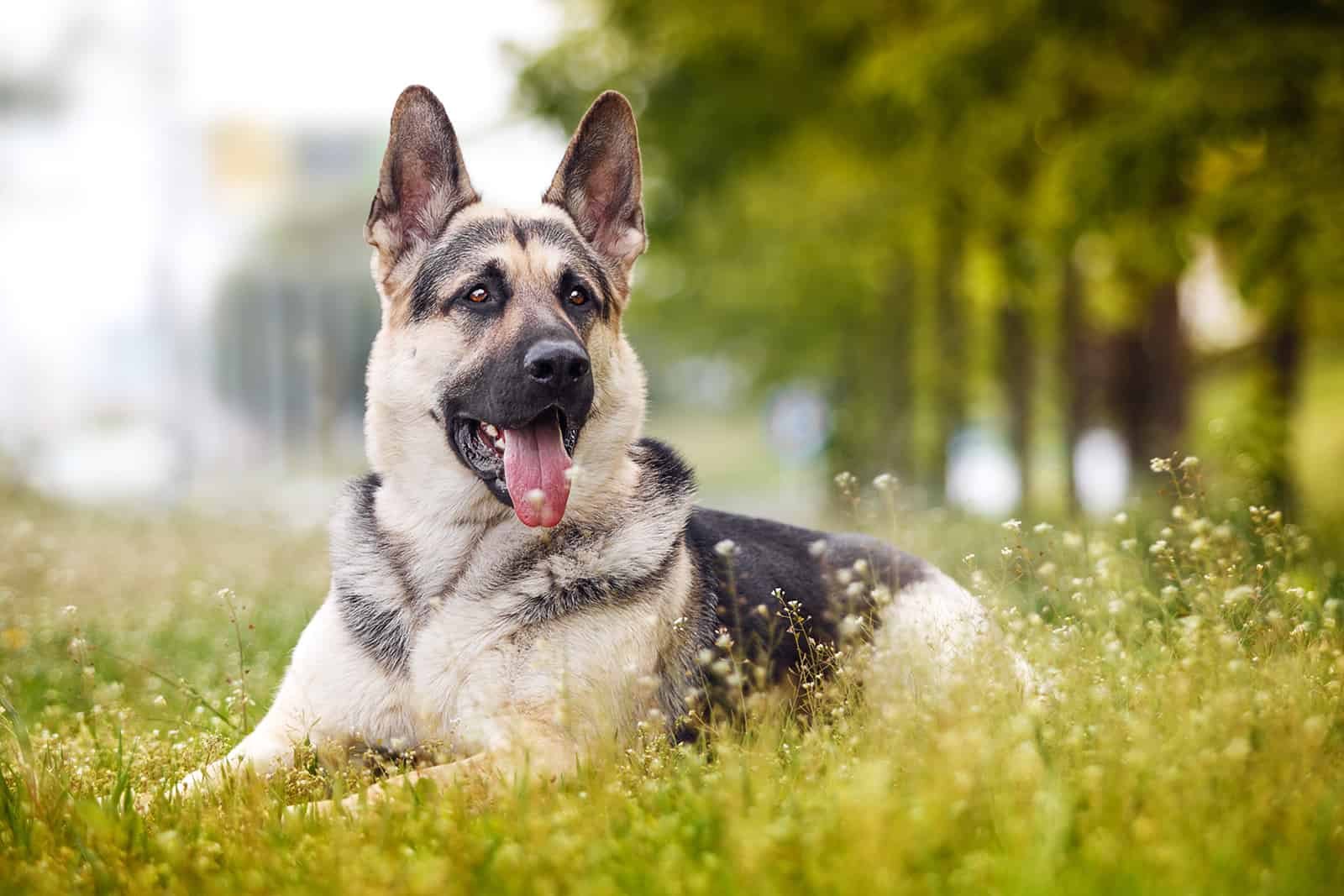
Background story
The first time I saw an East European Shepherd, I thought that it was a Belgian Malinois or even a Dutch Shepherd. But, soon enough, I realized the differences between the breeds and that the East European Shepherd has a different background story.
These dogs were purposely bred to serve as police dogs in harsh Russian climate conditions. The main goal was to create a dog breed as good as the average German Shepherd girl or boy. Was the goal met? Absolutely!
In fact, they seem like an improved version of the GSD. East European Shepherds have been very popular all over the Soviet Union. But, their popularity didn’t exceed the boundaries of the Union.
Appearance
As I mentioned earlier, the East European Shepherd was influenced by the looks of Shepherd dogs from Germany, Belgium, and Holland. Some specimens of the breed even resemble the GSD, with a slightly shorter coat.
Usually, the East European Shepherd features a medium-length dense coat that can come in pure black, black and tan, sable, and even white. Remember the white German Shepherd? Well, this pup really shares the GSD’s coat colors.
But, one thing that sets them apart from the GSD is their size. The East European Shepherd is much bigger than the GSD and has their beast mode turned on all of the time.
Temperament
When I mentioned beast mode I did not mean that these dogs are savage. Well, neither GSDs are aggressive nor their cousins Belgian Malinois. Don’t expect these dogs to act like they’ve never been in touch with humans.
East European Shepherds are courageous dogs with lots of confidence, no matter what they do.
9. Black Russian Terrier
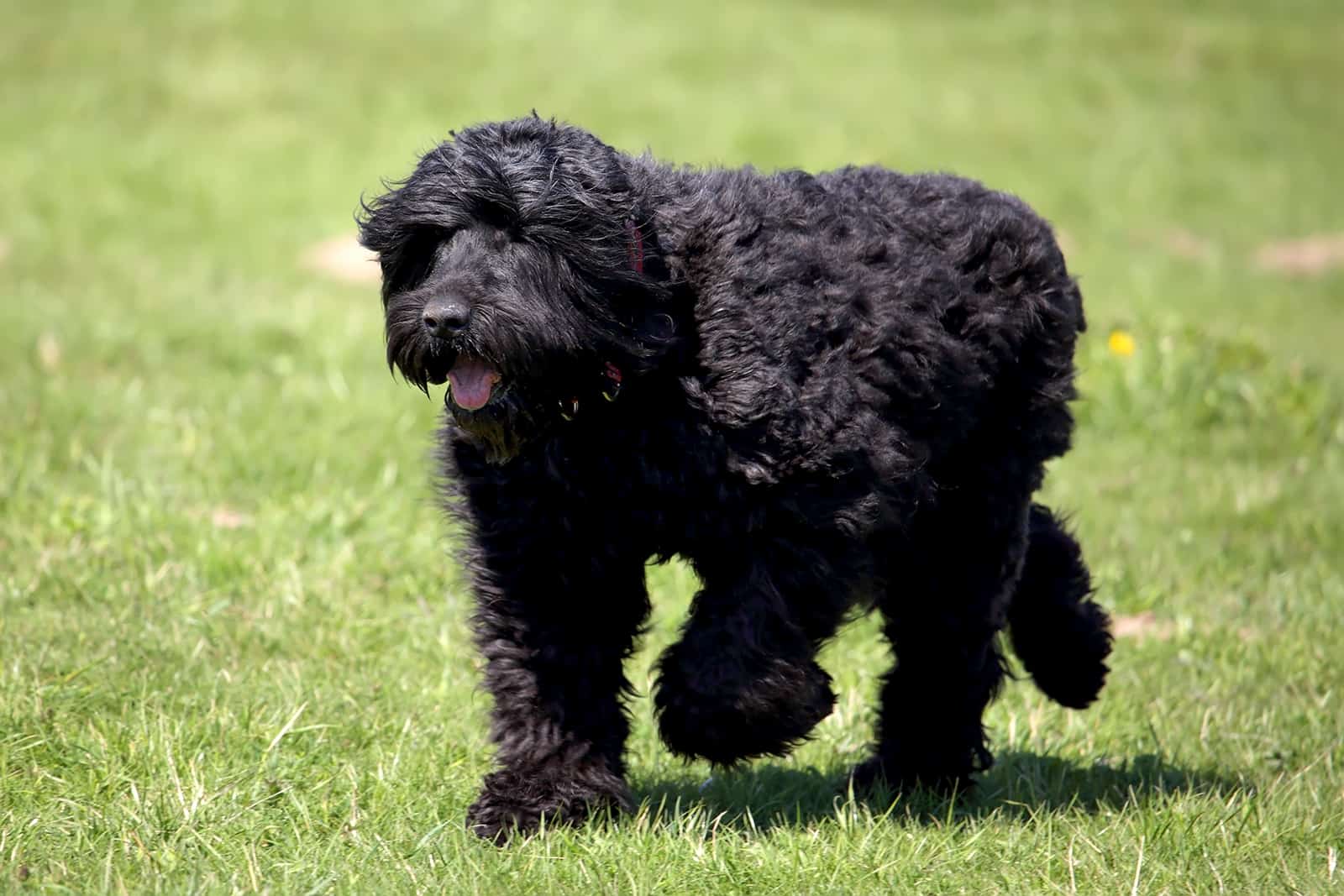
Background story
You might think that all terriers are the same, but no. The Black Russian Terrier is not at all like other doggos out there.
This Russian dog breed was designed back in 1940, so yeah, it’s a pretty new dog breed.
What’s interesting about them is that they were bred using working lines of mostly German dog breeds, like Giant Schnauzers and Rottweilers. The goal was to create the ultimate Russian working dog.
Black Russian Terriers were the stars of the 20th century in Russia for their exceptional work ethic and overall lovely appearance.
Appearance
Speaking of appearance…
These Russian dogs are actually Russian giants! An average Black Russian Terrier can weigh almost 140 pounds!
They’re big and mighty Terriers, unlike most examples of the terrier breed, which are usually tiny and super energetic (yes, I’m looking at you, Toy Rat Terrier!).
And do you know why they aren’t like other terriers? It’s because the Black Russian Terrier isn’t really a terrier. He’s a working dog.
What makes Black Russian Terriers so stunning, other than their large size, is their gorgeous waterproof coat. Of course, their signature color is black, but occasional salt and pepper coat options are accepted too.
Temperament
So, we now know that the Black Russian Terrier is a working dog. These pups were designed to cater to the needs of military forces.
This made them perfectly calm and easy-going, with a firecracker temperament that turned on exactly when they needed it.
Black Russian Terriers know when it’s time to play and when it’s time to work hard. And they never fail.
10. Shalaika
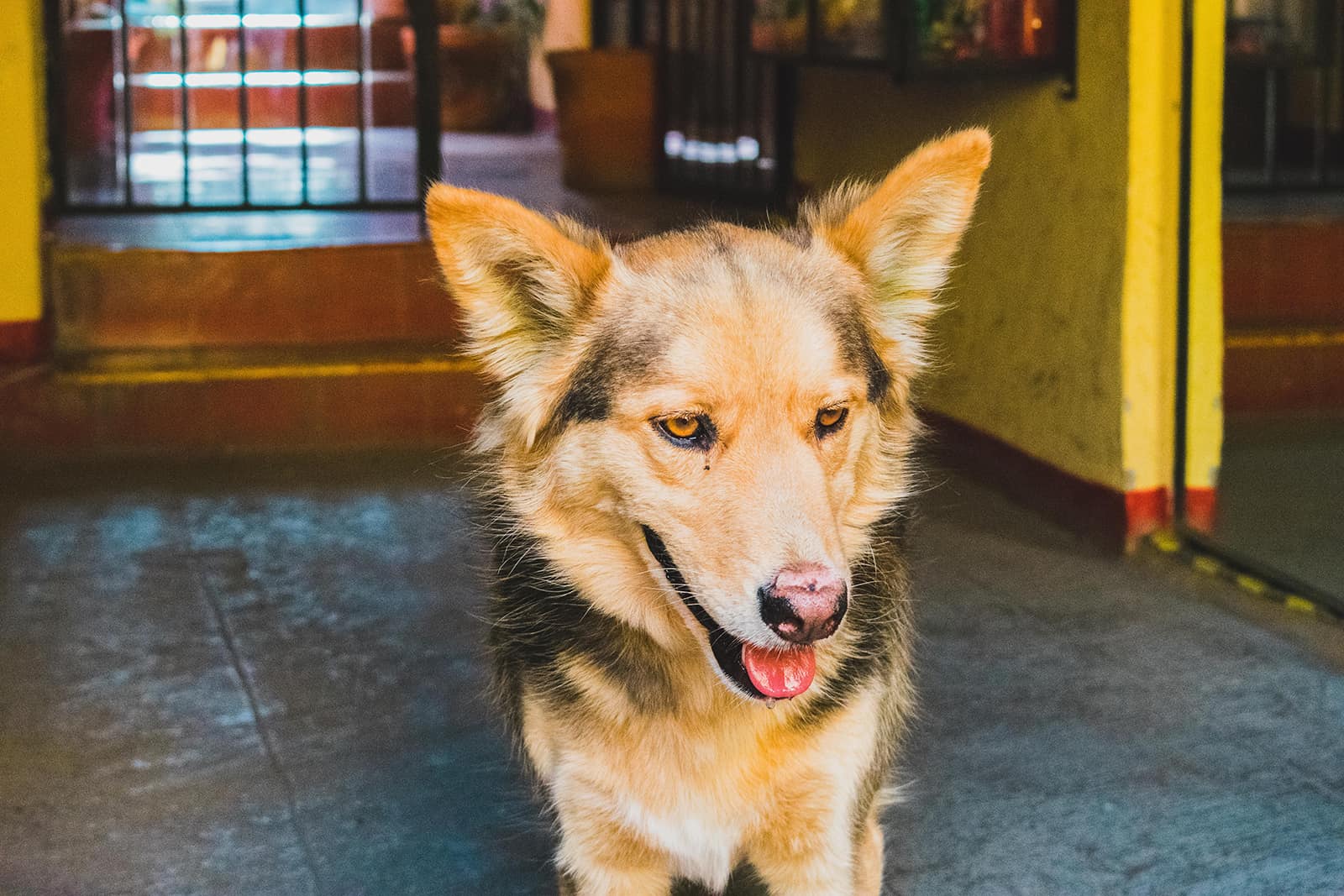
Background story
It’s time to meet one of the Russian dogs with a funny name! Here’s the Shalaika!
Okay, you may know it under a different name, the Sulimov dog.
Actually, okay, you may not know this dog breed at all since it’s so new and its origin is shadowed in mystery.
This is, actually, the first jackal hybrid dog from Russia. They were purposely designed to serve the Russian airline, Aeroflot. And let me tell you something, these dogs weren’t just employed for nothing.
The Sulimov, or Shalaika, has proven itself efficient in sniffing parcels for explosives or prohibited substances. Just recently, the Sulimov was even trained to detect coronavirus by scent.
Luckily, the pandemic is (hopefully) over and they can go back to their regular sniffing tasks.
Appearance
The Sulimov is one of those dogs that looks a lot like a fox. While it’s technically impossible to breed canines and foxes, we can’t shake off the resemblance that these dogs have with our foxy feral friends.
The Sulimov dog has pointy ears and a rather long muzzle. Their coats are, surprisingly, dense and smooth. And, boy, they come in so many colors! After all, this is a hybrid dog, isn’t it?
Temperament
Besides their amazing sniffing abilities (just like without Beagle boys and girls), Sulimov dogs are highly intelligent creatures. Their intelligence almost borders on craziness.
But, all jokes aside, an average Shalaika may wander off because he’s so into investigating and satisfying his curiosity. The only thing that they like better than this is satisfying their owners.
They are eager to please dogs and there’s nothing they can’t tolerate. Not even harsh temperatures that dip below zero!
11. Volkosob
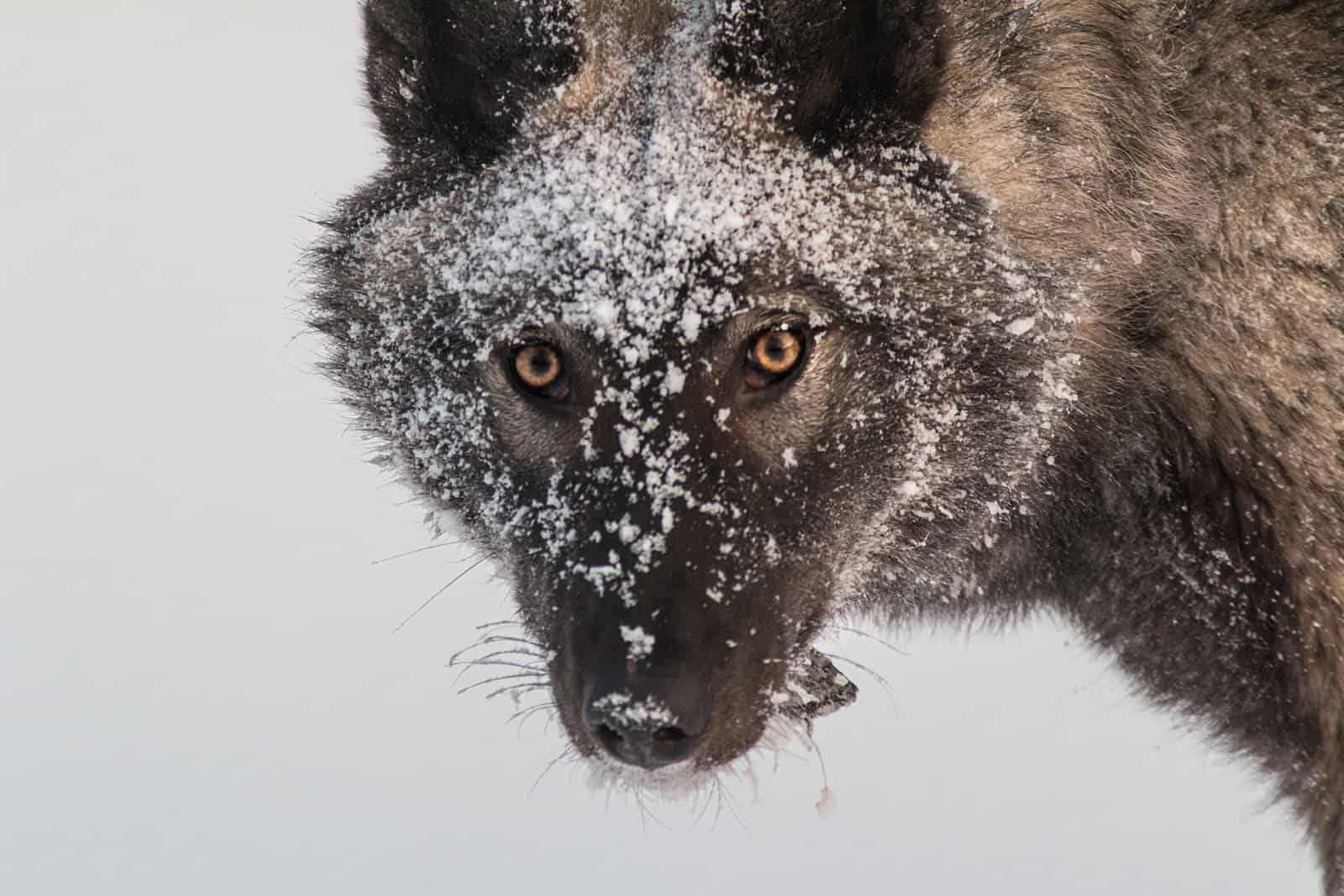
Background story
Wolf-dog hybrids are not something we’re all used to. Breeding them on purpose is not something that should be done without careful thought. And, it’s not something everyone can do.
The sole purpose of wolf-dog hybrids, like the Volkosob, was for them to serve as protectors of the Russian boundaries. Some twenty years ago, when the breed was founded, keeping the boundaries safe was Russia’s #1 priority.
The first Volkosob was actually a female named Naida. She was a Caspian Sea Wolf and served as an inspiration for future Volkosobs and a breeding stock, thanks to her incredible friendliness and intelligence.
All Volkosobs are designed to not only keep the boundaries safe but to sniff for explosives and drugs. The bottom line is that the Volkosob may be Russia’s new ultimate military dog.
Appearance
All Volkosobs have a natural resemblance with our lupus buddy, aka the wolf. They fashion a thick coat that can endure freezing temperatures, and it usually comes in shades of gray, but brown and black are also possible.
These are fairly tall dogs, reaching almost 30 inches at their withers.
You’ll immediately recognize a Volkosob for its pointy ears, tiny sparkly eyes, and a wolf-like smug expression.
Temperament
When not performing their military duties, Volkosob dogs are highly devoted to their owners. Not many people have shown enough bravery to adopt a Volkosob because most people are afraid of their wild side.
Their temperament has not been tested for family living.
But, the Volkosob has shown great protection skills and territoriality. When around strangers, these dogs will show their teeth if they feel threatened, so be aware of that.
12. West Siberian Laika
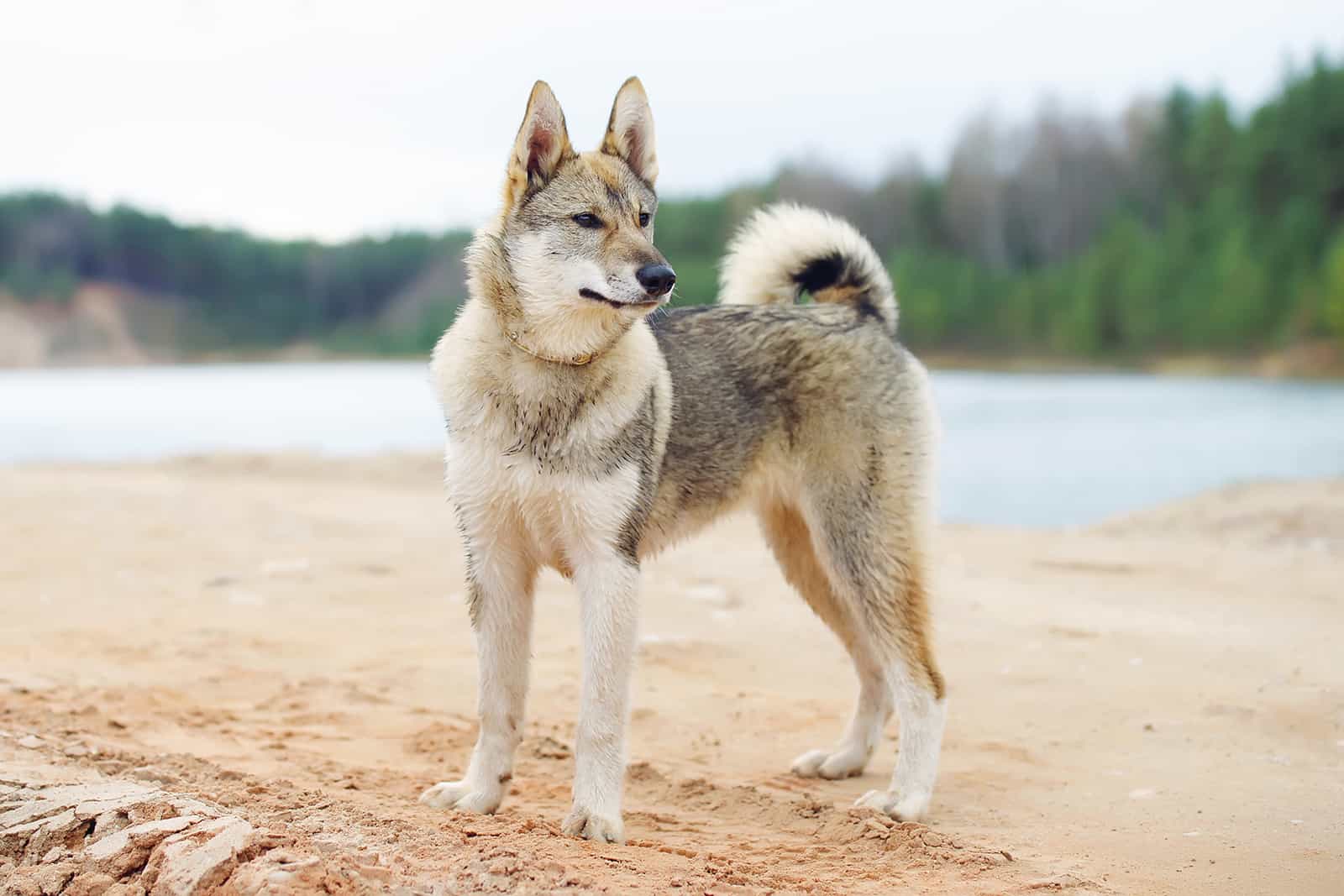
Background story
No, this isn’t a type of Japanese dog breed, like the Shiba Inu or Akita Inu. Although both Shiba and Akita Inu boys and girls are wonderful creatures, we’re focusing on a dog that just looks a bit like them.
Meet the West Siberian Laika, a dog originally from the west part of Siberia, specifically found with the Ural people of Siberia.
We don’t know much about the whole story of when this Laika was first bred, but we do know that they were used as talented hunting companions.
Appearance
West Siberian Laikas look a lot like Siberian wolves. They’re one of those wolf-like breeds. They have a thick coat that can endure low temperatures as if they were nothing. This makes them quite adaptable to any living condition.
As I mentioned in the beginning, the West Siberian Laika has rather pointy ears like other spitz dogs. Their muzzle is also long and pointed, while their coat color ranges from gray, black, white, and even sable!
Temperament
The West Siberian Laika, like all Russian breeds, is an obedient dog blessed with exceptional intelligence. These dogs are capable of hunting down almost anything, from small animals like rodents to large ones like raccoons.
Their high prey drive is what has helped them to survive all these years in Siberia.
Even though they like to hunt, these Laikas are not aggressive by any means. They are more cautious and will take a moment to evaluate a stranger before they welcome him into their circle of trust.
They’re protective and caring, something you’d never expect from a hunting dog.
13. Russian Tsvetnaya Bolonka
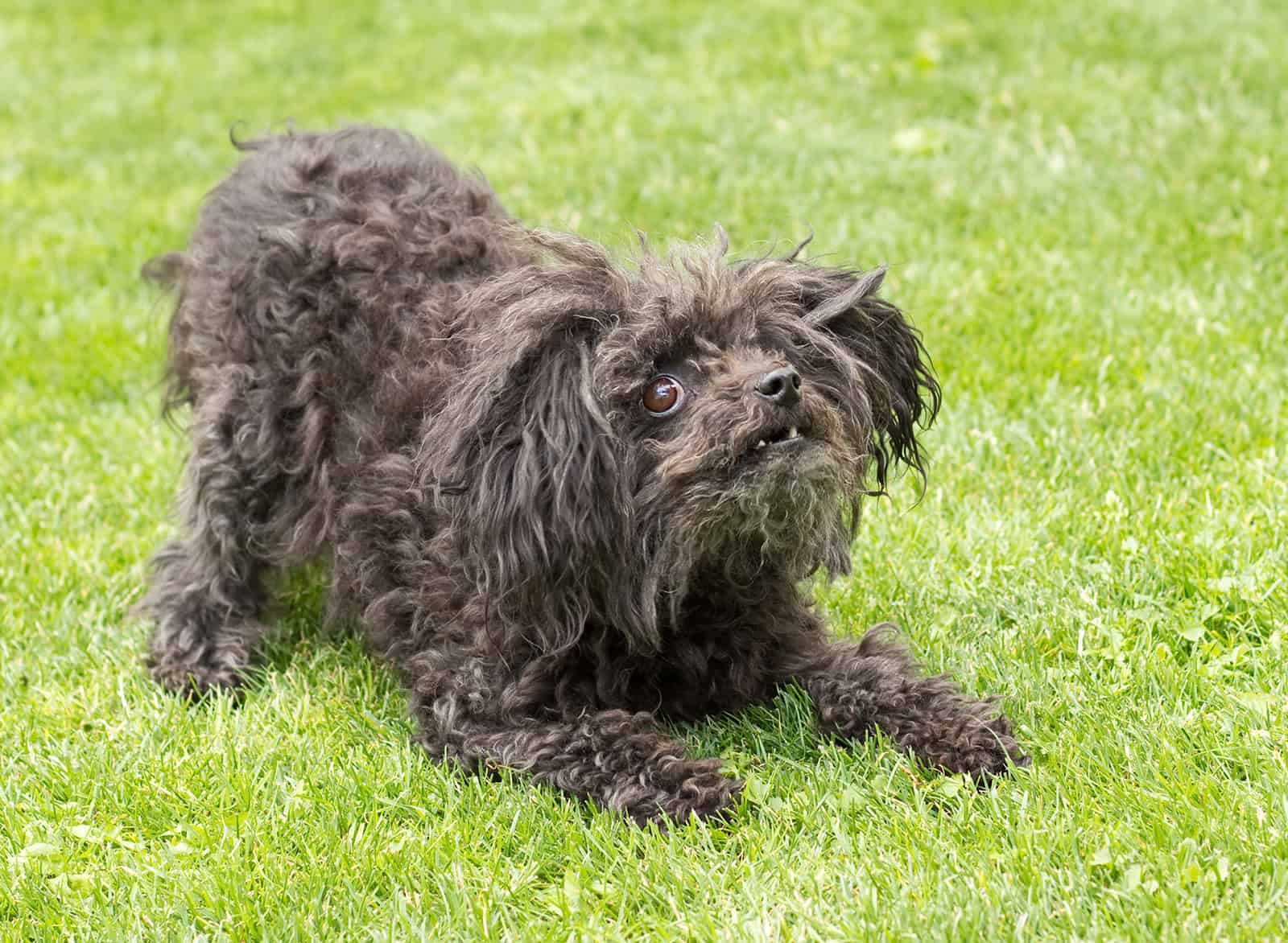
Background story
There’s another dog breed on this list of Russian dogs that looks a lot like our Tsvetnaya Bolonka, but we’ll get to that soon.
Now, I want to present to you the Russian Tsvetnaya Bolonka, a curly ball of joy that was bred to become the ultimate toy dog for apartment living. The Tsvetnaya Bolonka is the lap dog that you didn’t know you needed, and you’re about to see why.
This dog breed was designed using males and females of the following dog breeds: Bichon Frise, Bolognese, Shih Tzu, and Pekingese. The end result was an adorable little pooch, often just called a Bolonka.
Who’d have thought that adorable and Russia go together in any way? Well, not every Russian dog is feisty and mighty.
Appearance
Due to the parent breeds used in the breeding process, the Bolonka features a curly coat that does not shed. The best thing about these dogs is that they’re hypoallergenic. Yes, Russian dogs can be hypoallergenic too!
Of course, this means that you won’t find a Bolonka guarding sheep somewhere around the Caucasus mountains.
Our little Bolonka buddy will range in coat colors from gray, white, and black, to cream, fawn, red, and even silver like wolves.
Temperament
A Bolonka is exactly what you can expect from a lapdog. They’re sweet, caring, and love cuddling up with the family. They expect affection and will offer tiny dog kisses in return.
What they will never offer is aggression. These dogs don’t have a single bad bone in their body.
14. Hortaya Borzaya
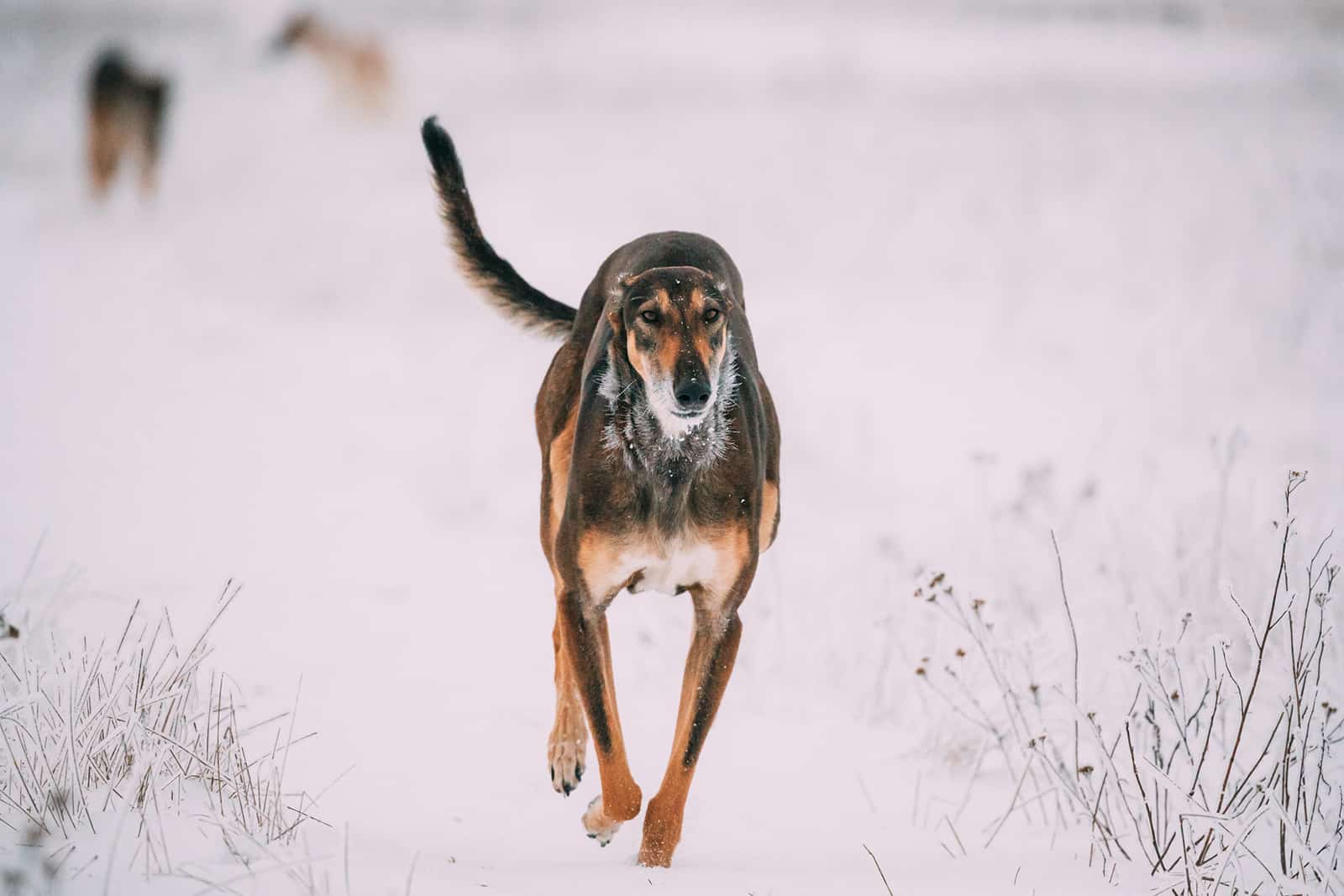
Background story
Our Borzoi buddy is not the only Greyhound-like dog on the list of best Russian dogs. We can’t forget about the Hortaya Borzaya.
If this name is too hard for you to pronounce, you can try using Chortai or Eastern Greyhound.
So, are these dogs really Greyhounds? Yes! But, there’s always that but…
The Hortaya Borzaya is like a cross between the mentioned Borzoi and an average Greyhound. But, unlike their Greyhound friends that usually hunt animals (fake ones) just for fun and the run, Hortayas hunt to survive.
This Russian dog breed is impossible to find in big cities. In fact, it’s a favorite breed for local farmers who need Chortais to help them hunt animals for food.
Appearance
The Hortaya Borzay shares a lot of appearance traits with Greyhounds. Do they shed like Greyhounds? Yes, especially when the Hortayas have a feathered coat.
What sets these dogs apart from the Borzoi and other Greyhounds is their bigger body structure. But, that doesn’t stop them from performing everyday Greyhound duties, like running after tiny prey.
Hortayas are elegant canines, with almost feline-like movements. You can definitely say grace is one of their biggest traits.
Temperament
What many dog owners, especially those with kids, love about Chortais is their soft grip. Their teeth will not penetrate the body of the caught animals and won’t hurt humans either.
Hortayas are very adaptable dogs and they don’t mind living with any family, as long as they get their daily dose of activity.
You’ll be surprised how gentle these unusual pups are.
15. Taigan
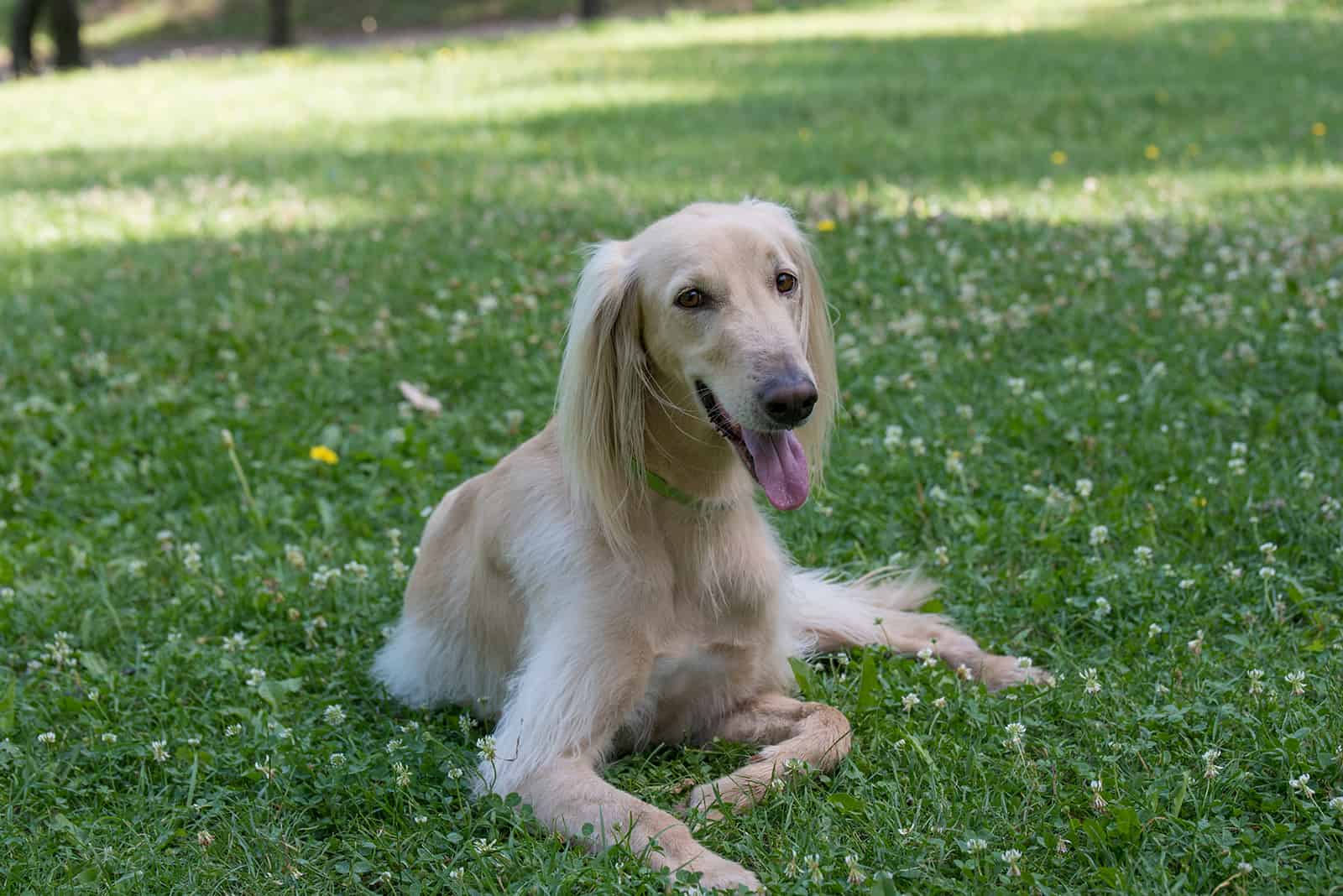
Background story
How does Kyrgyzdyn Taighany sound to you? Too complicated? I thought so…
What about just Taigan?
That’s much better!
The dog you’re about to meet is another rare Russian dog. In fact, it was created in Kyrgyzstan in the days when it was a part of the USSR.
Taigans were specially designed to live in almost impossible conditions. Living at higher altitudes, like 4,000 meters above the sea, is nothing special for these canines. They’re very adaptable and won’t make any fuss about it.
Taigans have been popular in Russia for the past 30 to 40 years. However, the official canine clubs still don’t recognize them as a separate dog breed.
Appearance
The first glance at a Taigan will make you think that this is another Greyhound from Russia. The truth is, they’re very much similar in weight, size, and overall body structure to Greyhounds. However, they’re not the same.
The Taigan is a sighthound, but he’s blessed with a lovely long coat, unlike the Greyhound’s. Their coat can even be curly, which makes these dogs even prettier.
Our Taigan friend looks a lot like another dog breed, the Afghan Hound.
Temperament
As far as its temperament goes, you’ll like the fact that the Taigan has more patience than any other dog breed.
They’re extremely loyal and respect their owners.
The two things that you must pay attention to around Taigans are small animals and little children. Taigans are known for their extreme speed and strong prey drive. Don’t be surprised if your house cat gets chased around.
Also, they don’t like playing roughly with kids, so keep an eye on their reactions to children.
16. Russo-European Laika
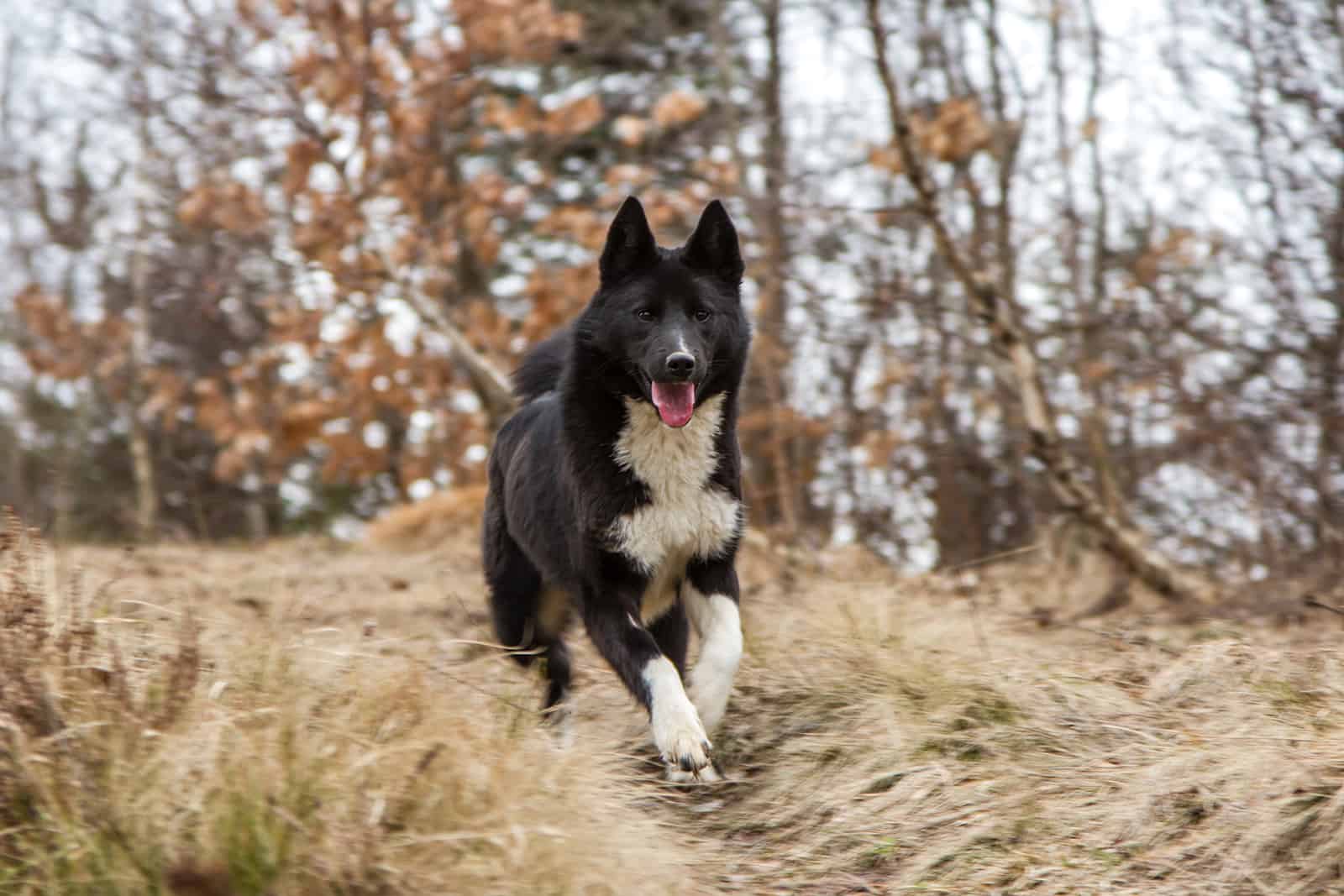
Background story
No, that dog you see is not a Border Collie boy or girl. We call these pooches Russo-European Laikas. They may look similar to Collies, but they’re nothing like those smart canines.
The Russo-European Laika was produced from breeding Russian landrace dogs back in 1940. The end result was a dog breed that was so skilled in hunting, that it soon became the Soviet’s pride and joy for duck hunting.
Russo-European Laikas, like all the other Laikas on this list, are a spitz-dog. Unfortunately, neither the AKC or UKC recognizes this Laika, but the FCI does. I have a feeling that this will change eventually, since their popularity is rising.
Appearance
As you already know, we have lots of Laika dogs on this list. The Russo-European Laika is definitely the smallest of them all.
But, that doesn’t mean that they’re tiny or fragile. This Russian dog breed is characterized by its medium-sized body with solid muscles and an overall sturdy structure.
Like all spitz-type dogs, their tail is curled up and theor ears are nice and pointy.
This Laika fashions a rather dense coat with a coarse top coat. The hair gets a bit thicker around their neck.
The reason this Laika may remind you of Border Collies is their signature black and white coat color. Other colors like white, gray, and salt and pepper are also possible.
Temperament
The Russo-European Laika is definitely the best Laika for families. Given the fact that they’re compact-sized and have a lovely temperament, these Laikas are the real superstars of all Russian dogs in terms of family living.
Sure, they may act a bit territorial, but that’s only because of their strong guardian instincts.
These Laikas love spending their time outside in nature, so if you’re a nature lover, you’re gonna enjoy living with this Russian dog breed.
17. Karelo Finnish Laika
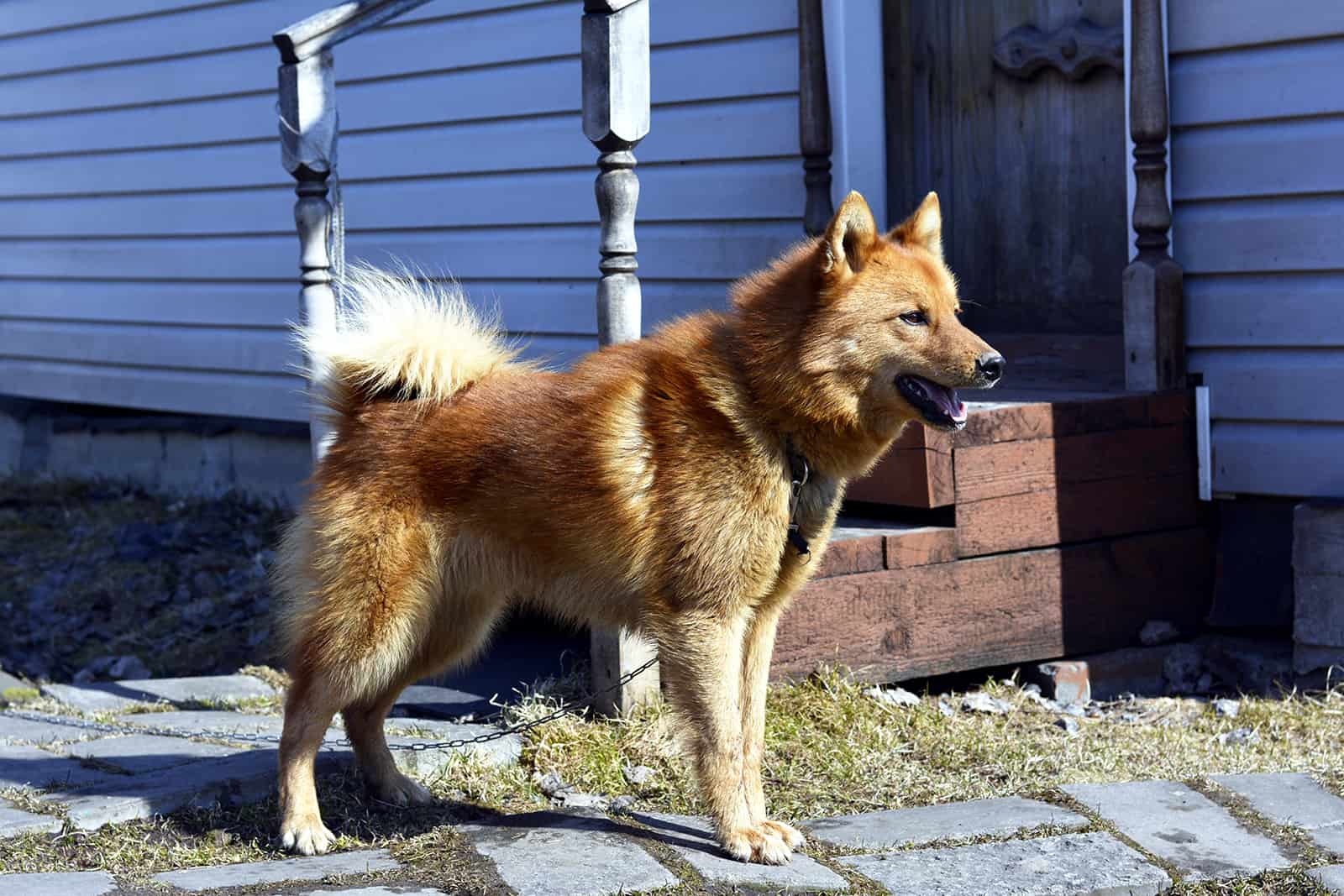
Background story
It feels like all Russian dogs are either spitz dogs or Russian sheepdogs, right? Well, I can’t blame them for having a type.
Russia, including the former Soviet Union, is a huge place and most of it features harsh temperatures. They need dogs like the next one to survive crazy, cold Russian winters.
Our next dog is called the Karelo Finnish Laika. This dog breed was originally developed in a region called Karelia. This region borders Finland, so the name of the breed is completely justified.
This Laika is still not accepted as a separate dog breed by canine clubs.
Appearance
The Karelo-Finnish Laikas come in red, fawn, and black with white markings. Their coat is as dense as any other Russian dog on this list.
This dog breed is not as big as you might think. But, their compact size makes them agile, which comes in handy when they’re hunting large game.
The Karelo-Finnish Laika usually doesn’t weigh over 40 pounds.
What you’ll find interesting about this dog breed is its foxy appearance. When you see a red Karelo-Finnish Laika, you might think that you’re facing a real wild fox!
Temperament
The Karelo-Finnish Laika has two sides to its temperament. One is kind and sweet, especially loyal, and calm with families. The other one is hard-working, serious, devoted, and extremely skilled in hunting.
This dog breed was used to hunt small prey like geese, but also bigger game like bears. You can definitely say that these Laikas are courageous dogs.
What you must know about Karelo-Finnish Laikas is that they are sometimes overprotective and may act aloof around strangers.
18. Russian Spaniel
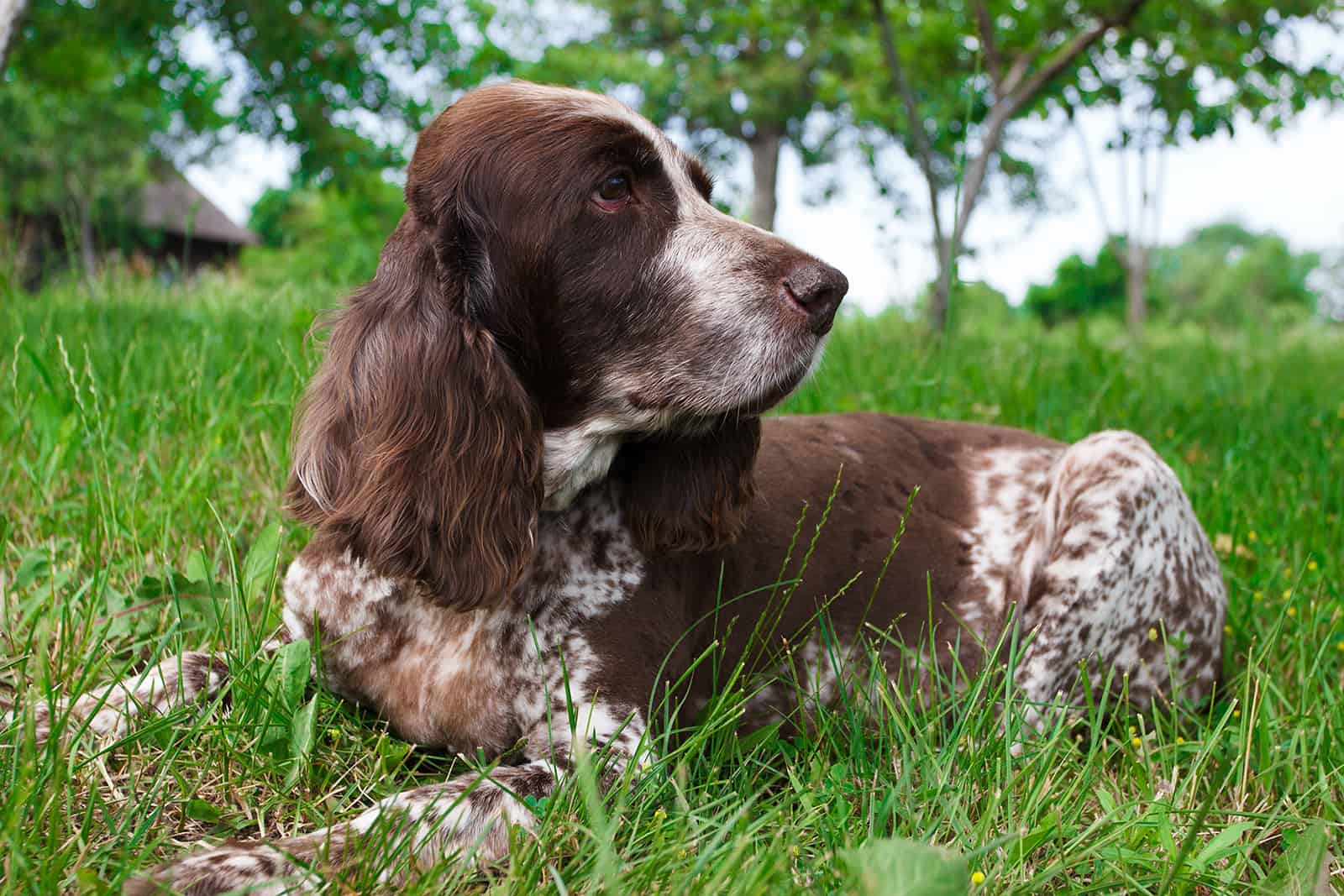
Background story
Let’s travel back to the 1950s. It was a hard time in the former Soviet Union during the Cold War. But, that didn’t stop Russian dog lovers and experts from breeding new dog breeds, including the Russian Spaniel.
What makes the Russian Spaniel different from Springer Spaniel or Cocker Spaniel boys and girls? Nothing! The Russian Spaniel was produced by breeding the other Spaniels that I just mentioned.
The end result is a dog breed that is very similar to its parents in all possible ways.
Appearance
The Russian Spaniel usually features spots or freckles on its coat, just like its parent breeds. They have some feathering around their legs and lovely curly ears. It’s the ears that make them resemble other Spaniels so much.
These Spaniels are slightly bigger than their relatives. Also, their coat seems to be denser. That’s what truly sets them apart from other Spaniels.
Russian Spaniels are considered to be small dogs. However, they’re fast, agile, and talented hunters. In other words. they’re exactly what a Spaniel should be.
Temperament
So, these are hunting dogs, right? Well, I have a better word for them. Russian Spaniels are great workers! Give them any task and they’ll manage to complete it without any hassle.
Russian Spaniels are very smart pooches and training them won’t make you lose your mind. Seriously, they’re as obedient as a dog can be.
What truly makes them great dogs is their easy-going nature. If you want to bring a Russian Spaniel into a home with kids, you can absolutely do that. They’re super-friendly and love spending time with little ones.
19. Russian Hound
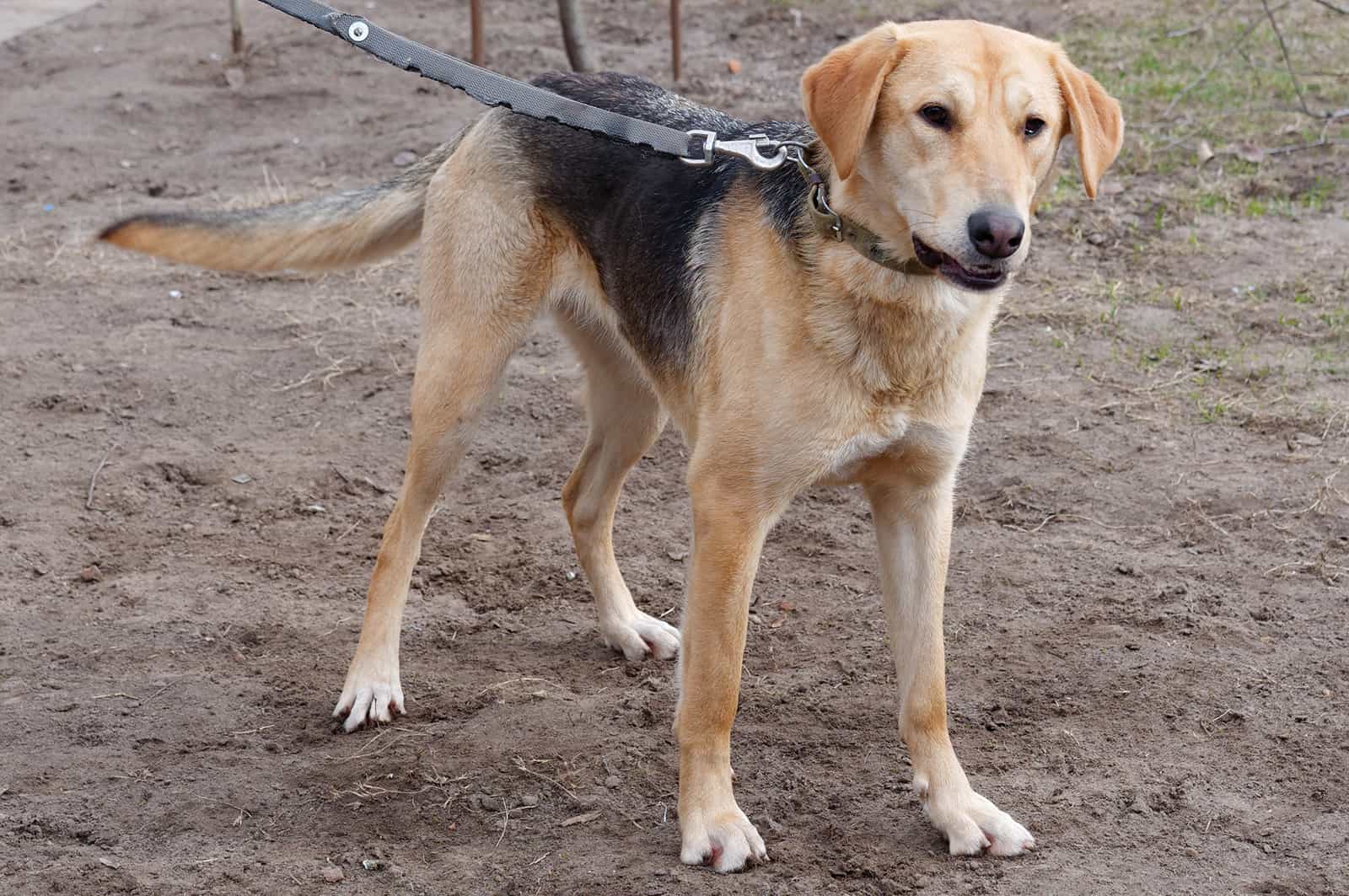
Background story
When you first see a Russian Hound, you’ll definitely think it is a mixed breed dog with unknown parents. I know, because I thought the same thing before I researched them more deeply. Our world is blessed with lots of different dog breeds.
But, I didn’t know we had purebreds that look like crossbreeds.
The Russian Hound is actually a dog breed with a rich history. They date way back to the 18th century. This is actually a scenthound and is very similar to the Basset Hound boys and girls in terms of their talent to sniff out interesting things.
Appearance
I’ve noticed a lot of similarities between the Russian Hound and Basset Hounds or Beagles. That’s mostly thanks to their similar coat colors. Russian Hounds usually fashion coats in shades of yellow and red, with patches of black and white.
Their coat is short and coarse to the touch, However, their undercoat is super soft.
An average Russian Hound won’t weigh over 70 pounds. This is to keep them agile and ready to react when prey jumps in front of them.
Temperament
The Russian Hound does have a strong hunting genesis, but they’re friendly and sweet dogs overall. I feel like every Russian dog is extremely loyal and obedient. After all, they were purposely bred to be that way.
The same goes for our Hound buddy. They love pleasing their owners and listening to commands more than anything. Okay, they love snuggling at home too!
Even though this is a scenthound, born for hunting, the Russian Hound is definitely one mellow-hearted companion that you didn’t know you needed.
20. Central Asian Shepherd
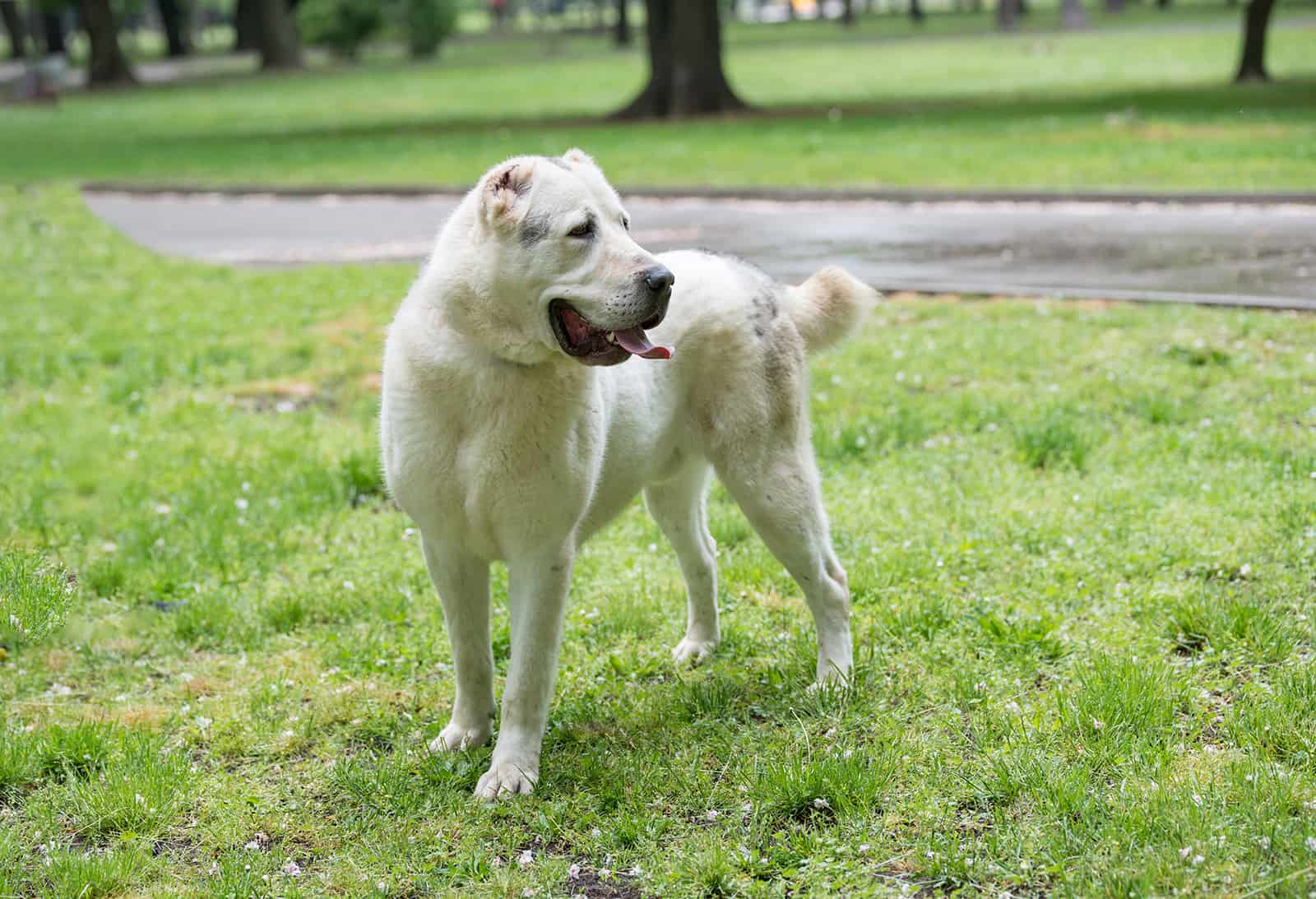
Background story
Meet another Russian dog on our list of the best Russian dogs that has ancient roots. The first examples of the Central Asian Shepherds appeared 5,000 years ago.
These dogs resemble Caucasian Shepherds a lot, but the actual breed standard for the Central Asian Ovcharka was developed in the 1920s.
The Central Asian Ovcharka has enjoyed quite the popularity for the past 20 years because she’s such a good guardian dog. At the peak of her popularity, Ovcharka’s border guarding skills were very much needed.
Appearance
We can definitely say that the Central Asian Sheepdog is a gentle giant.
They usually weigh over 100 pounds, which makes them not only good for herding cattle but also quite handy if any danger threatens you or your property.
This Ovcharka usually comes in white, but gray, black, fawn, as well as brindle patterns, are quite possible. Their coat features medium-length hair and it feels a bit coarse.
What you might not like about this dog breed is its drooling. Sadly, Central Asian Shepherds drool a lot, so make sure you keep this in mind if you want to adopt one.
Temperament
Central Asian Shepherds aren’t a good fit for first-time owners. These dogs need a firm hand, otherwise, they’ll take charge.
This brings along another issue: their protectiveness.
Sure, it’s great to have a dog that’s so protective of his family, but think about the strangers or new people you might bring into your life. You better have the Central Asian Ovcharka socialized in time, or you’ll be facing lots of behavioral troubles.
21. Moscow Watchdog
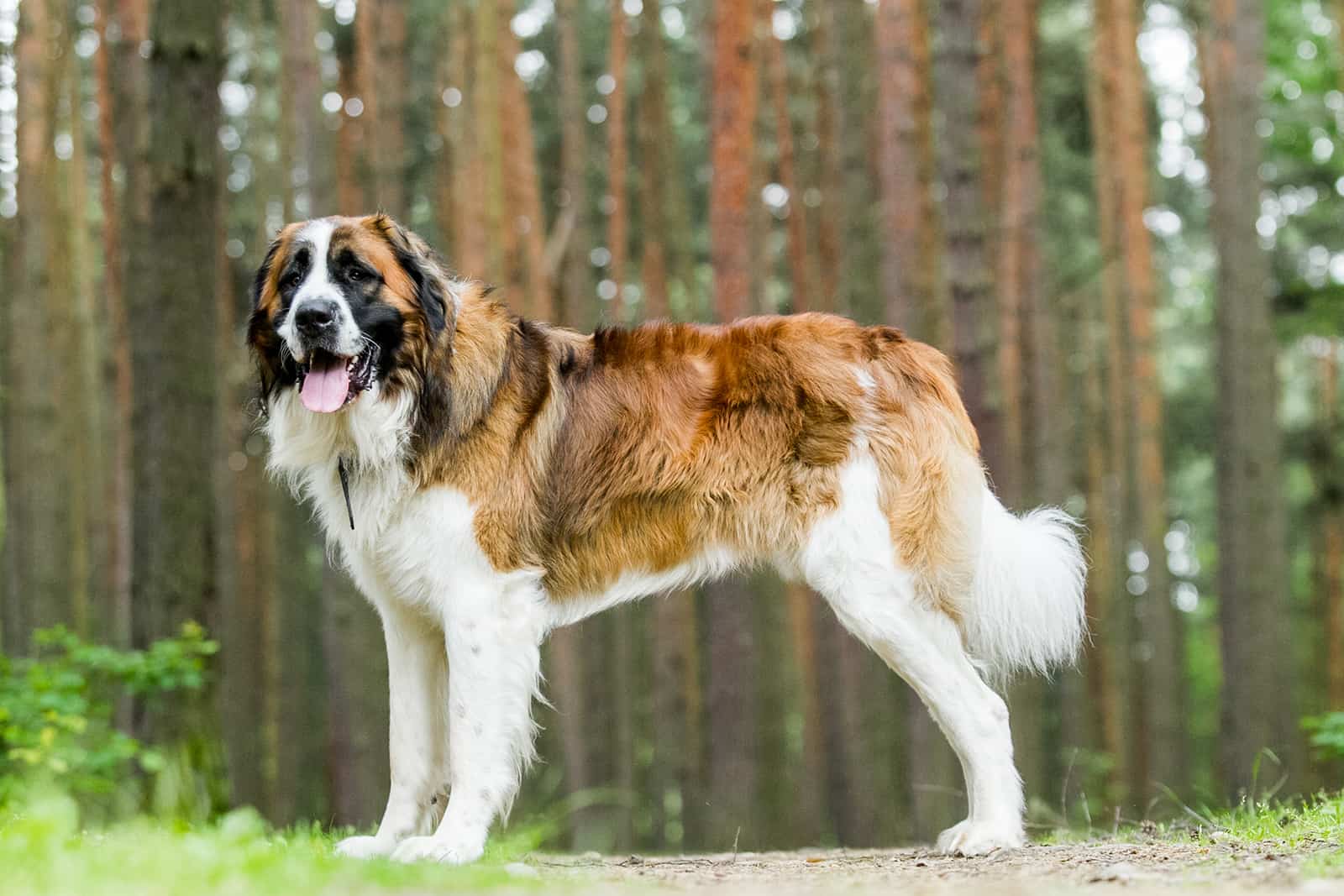
Background story
Does this dog look a lot like another you already know? Hmm, the resemblance is uncanny! This is the Moscow Watchdog, a cross that was produced using our dear St. Bernard. No wonder they look so much alike!
Actually, the St. Bernard was not the only dog breed used in this process. The Caucasian Shepherd is the other parent. These doggos were purposely bred in Moscow during World War II.
The crime rate inside Russia was at its peak. Local forces needed help with controlling railroads and warehouses.
Enter the scene, Moscow Watch Dogs!
This is one of those Russian dogs that you’ll struggle to find in the country, not to mention outside of it. As far as I know, there aren’t any registered in the USA. Still, their popularity seems to have been rising in the past few years.
Appearance
The Moscow Watchdog is definitely a giant dog breed. They tend to put on lots of weight as they grow, up to 150 pounds.
When you take a look at the Caucasian Ovcharka and the St. Bernard’s growth charts, you can see that the size of their puppies is destined to be at the higher end of the scale.
Moscow Watchdogs feature the same colors as their St. Bernard parents. Red and white is definitely the most common color that their thick, moderately-shedding coat comes in.
Everything is big with these dogs, from head to tail! But, the biggest thing is definitely their heart.
Temperament
It’s good to meet another one of the gentle giants. These dogs come with so many benefits for us humans. For starters, their intimidating sizes will keep us safe and secure all of the time.
Not many people want to mess with a dog as big as the Moscow Watchdog.
Besides being ultimately protective and loyal, these dogs are also very calm and gentle. They can easily live with kids, but teach your kids how to approach them first.
Moscow Watch Dogs are overall docile creatures, with a tendency to show their territorial behavior. As long as you have them under control, nothing terrible will happen.
22. Russian Harlequin Hound
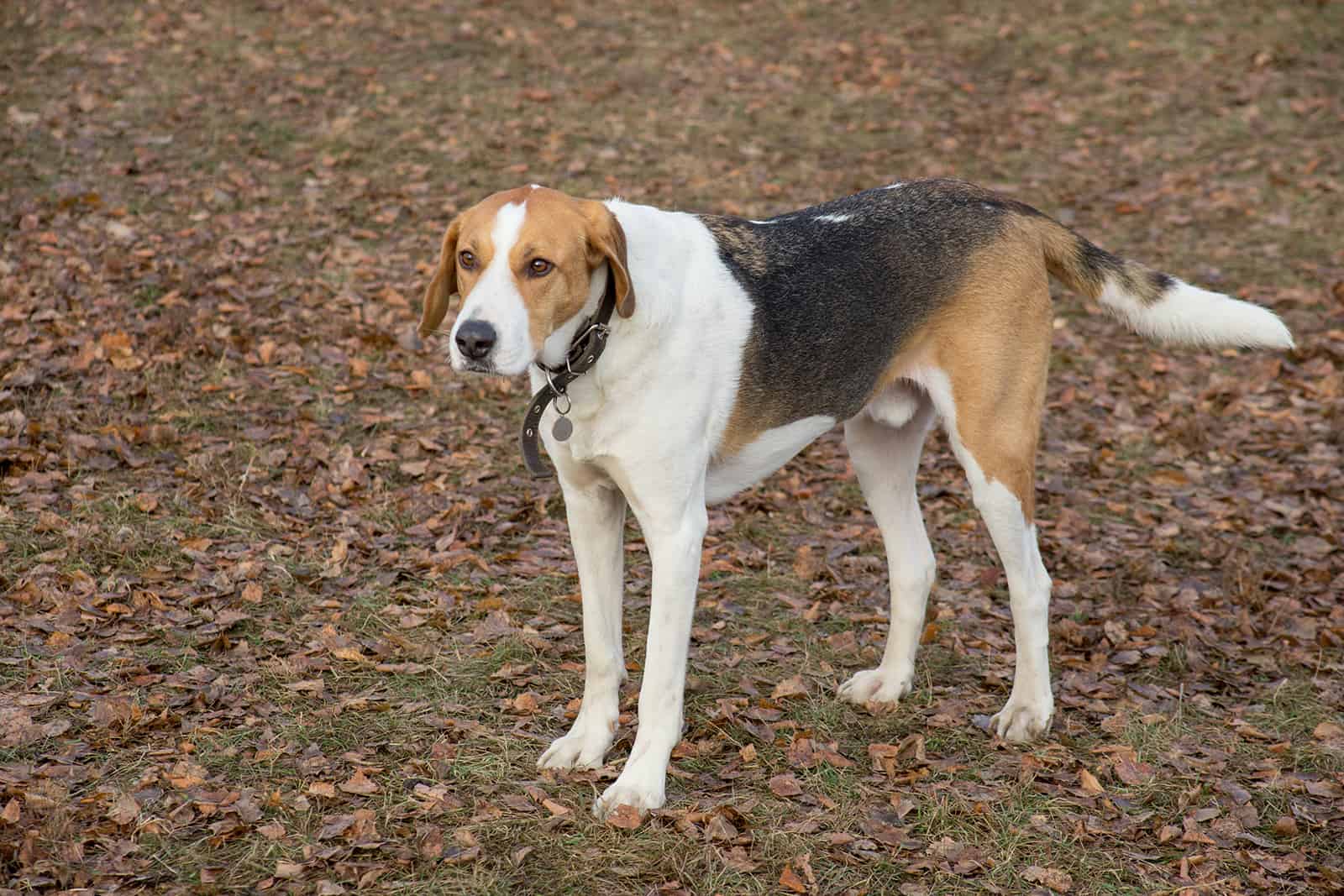
Background story
No, this is not an overgrown Beagle male or female. This is a purebred Russian Harlequin dog. You’re gonna love this extremely rare pooch for its terrific hunting instincts and overall kind temperament.
That is, if you manage to find one. Harlequins are so rare that it’s even hard to find them in Russia or in ex. Soviet Union countries.
The reason why this dog looks so familiar is that it’s a mix of a Russian Hound and an English Foxhound.
Appearance
Russian Harlequin Hounds belong to the group of medium to large dogs. They have a rather solid body structure with straight, long legs. Sometimes, they remind me of tall Bassets, especially because of their ears.
They’re big, droopy, and set really high on their heads.
This Russian dog usually comes in tri-color coat options, red, black, and white. They‘re fairly easy to groom and won‘t cover your place with dog hair.
Temperament
As excellent scent hounds, Russian Harlequin Hounds are very focused, devoted, and simply brilliant. Their hunting skills are beyond any regular talent. It’s just something that’s written in their DNA.
An average Russian Harlequin Hound will stay loyal to its owner no matter what. They act friendly around family, and a bit aloof around newcomers.
Would I recommend them for family living? Absolutely, but keep in mind their vocal skills.
23. Franzuskaya Bolonka
Background story
We’ve already discussed another Bolonka on our list of the best Russian dogs, but now it’s time for the other one. Meet the Franzuskaya Bolonka, a cousin of the Tsvetnaya Bolonka and one of the cuddliest dogs in Russia.
Of course, we’re not used to cuddling Russian dogs. We’re used to mighty paws that amaze us with their strength and agility. But, this pooch will definitely amaze you with his temperament.
The Franzuskaya Bolonka has different parent breeds and roots that reach back to France and Italy.
This dog breed was produced by breeding toy Poodles and Bichon Frise dogs from France, as well as Bolognese dogs from Italy, hence the name Bolonka (Bolognese).
There is also some Pekingese and Shih Tzu blood in them. Maybe some of the dogs, i.e. male or female Shih Tzu, were used in the breeding process at some point in the past.
Appearance
The Franzuskaya Bolonka will amaze you with her curly coat. Of course, they have inherited hypoallergenic traits from their parent breeds. Even though this dog has Shih Tzu blood and its hypoallergenic coat, it doesn’t have the Shih’s coat colors.
The Franzuskaya Bolonka can only come in white, no other color is accepted.
These are tiny lap dogs that don’t weigh over 10 pounds. You can cuddle with them and bring them along everywhere you go.
Temperament
Even though they’re so tiny, Franzuskaya Bolonkas are still excellent watchdogs. They’re very territorial and want to protect what’s theirs. Of course, you should not let them fight bigger dogs since they’re so small and could get hurt.
Franzuskaya Bolonkas are generally sweet and cuddly. They’re loyal pets that will follow you everywhere you go, but they’re not velcro dogs. They’re happy-go-lucky doggos that will bring a smile to anyone’s face.
24. Moscow Water Dog
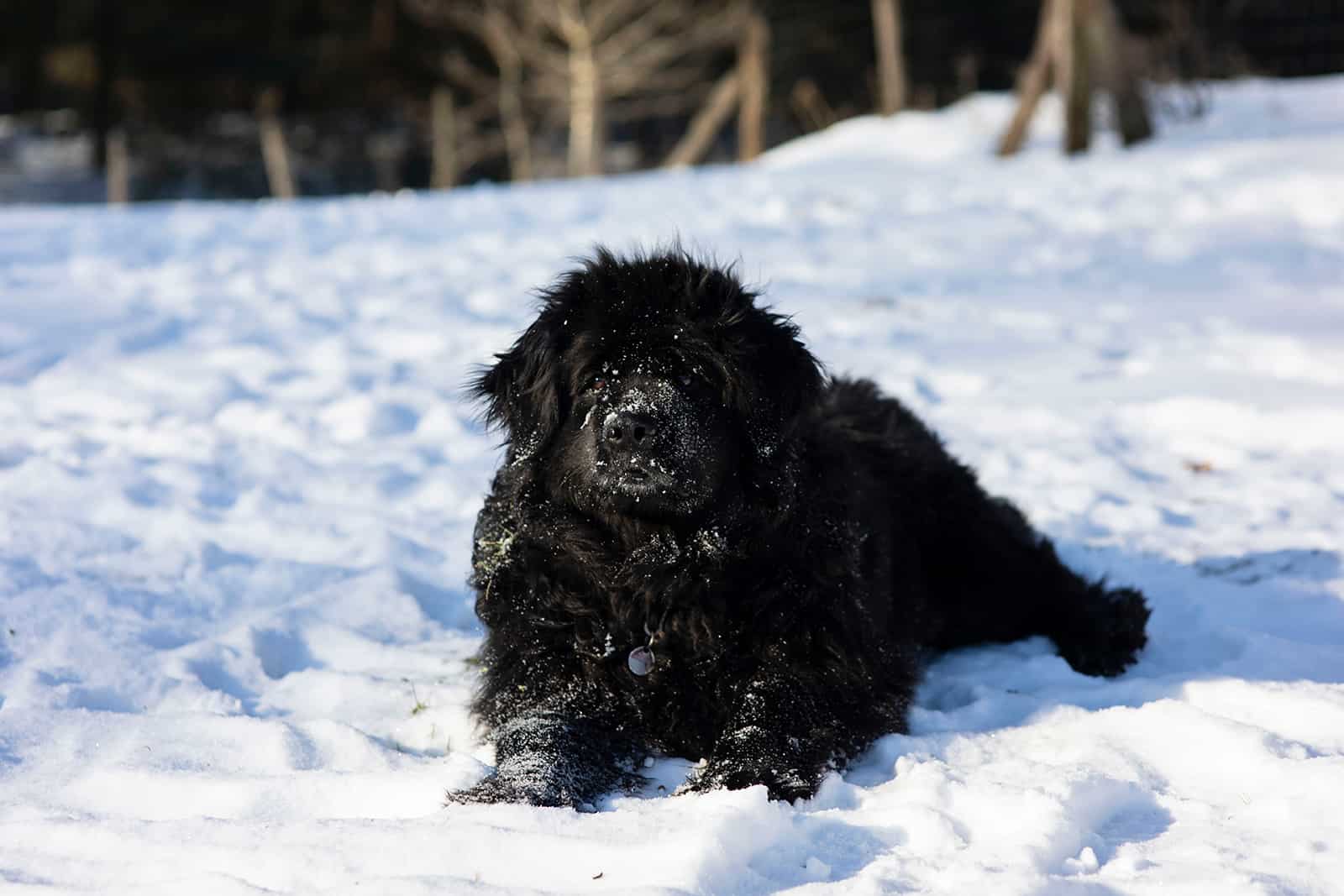
Background story
We have a Moscow Watchdog, and now we have a Moscow Water Dog.
Have you ever heard of the breed called the Russian Newfoundland? I bet you haven’t! But, this isn’t a distant Russian cousin to our Newfie buddies.
This is actually a cross between the Newfoundland, the Caucasian Shepherd, and the East European Shepherd. Of course, the resemblance to the Newfie is unbelievable.
The Moscow Water Dog was first bred back in the 1950s. The goal was to produce a dog breed that would serve the Russian army. However, these dogs failed in their purpose and they had to exclude them from service.
The reason was simple: aggressive behavior. It was impossible to handle them.
Later on, the Moscow Water Dog did manage to help with the breeding of the popular Black Russian Terrier. However, that’s about it. Today, this dog breed is considered extinct.
But, I had to include them on the list since they played a major role in the breeding of our valued Black Russian Terrier.
Appearance
The Moscow Water dog was definitely a giant among all Russian dogs. Their huge bodies were covered in a long, dense coat, which was usually black. Their head was wide and blocky, while their tail was long and feathered.
Moscow Water Dogs had tiny, round eyes and small floppy ears. The expression on their face was a bit sad, as if they knew they were about to go extinct.
Temperament
Sadly, the use of these dogs was discounted because of their aggression. But, that wasn’t the only personality trait that these dogs had. Moscow Water Dogs were courageous and packed with confidence.
They were excellent swimmers and generally great workers.
However, socializing with them was a struggle. Even if you thought you’d managed it, they’d prove you wrong. So, maybe it’s better to have them as only a memory.
25. Russian Toy Terrier
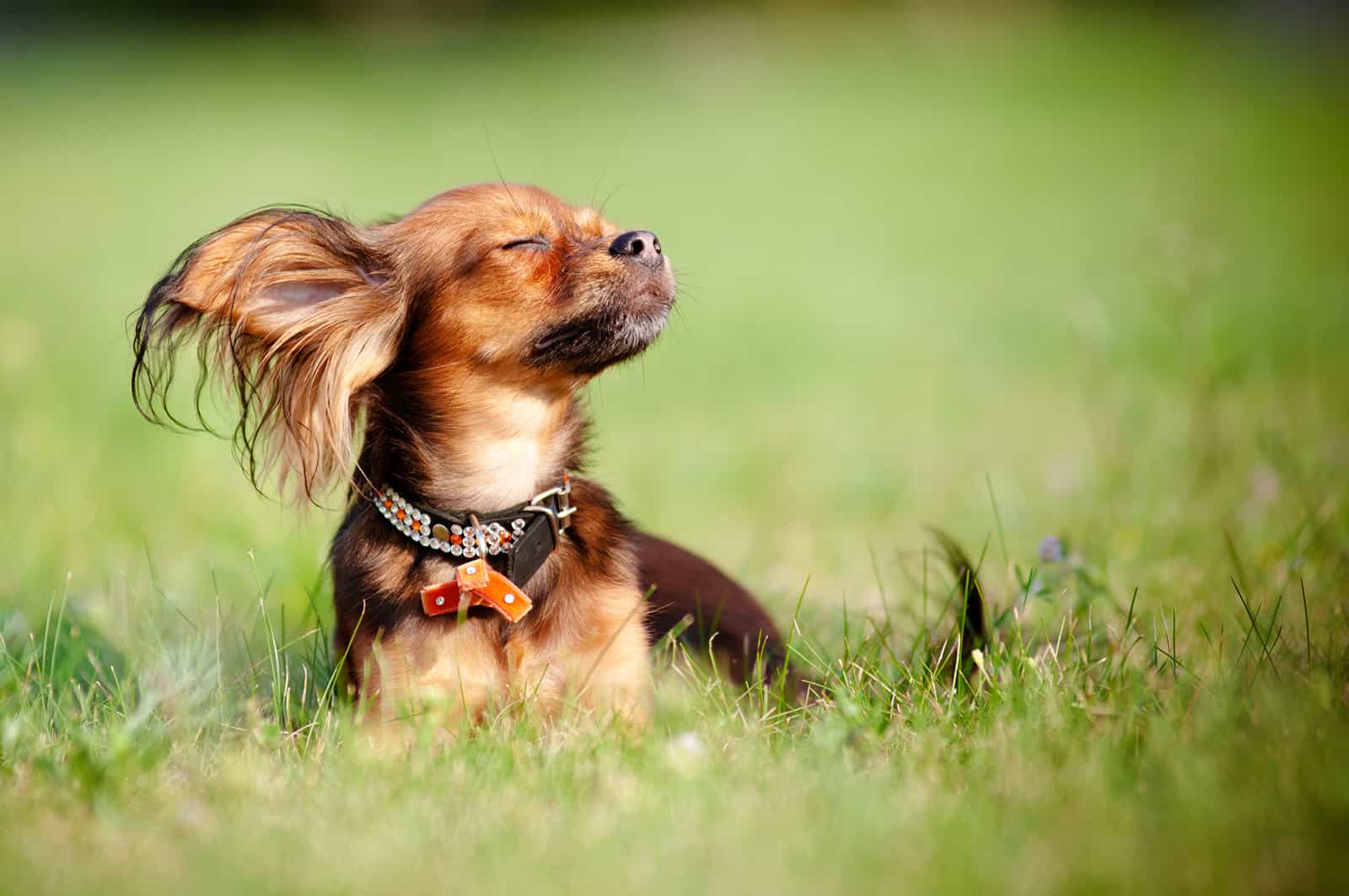
Background story
With those huge, bat-like ears, this dog can hear what’s going on in the arctic tundra of Siberia.
All jokes aside, let’s meet a lovely little fellow that will charm you with its appearance and knock you over with its personality.
This is one of the few lap dogs that was originally from Russia or the former Soviet Union. Their name is the Russian Toy Terrier, but you can also call him the Moscow Toy Terrier. And yes, he’s a real gentleman from Moscow.
The origins of this dog breed are linked to breeding the English Toy Terrier with some other tiny dog breeds. The result was a dog as tiny as a little Chihuahua boy or girl.
Sadly, this dog breed almost became extinct, not only once, but twice.
Since the Russian Toy Terrier was bred for Russian aristocracy, the fall of the Empire and the rise of the comunism almost whipped out these pups. All because of their connections to the old Russian royalty.
Also, when the Iron Curtain fell in 1989, many new dog breeds from the west came to Russia and the former Soviet Union. The new dog breeds completely replaced the Toy Russian Terriers in their cozy homes.
Appearance
An average Russian Toy Terrier weighs no more than 7 pounds. So, do you now realize how small these pups really are?
I know what you may be wondering: Will he grow into those giant ears?
Sadly, no, but that only emphasizes the charm of this pooch. Russian Toy Terriers are known for their tiny bodies with triangular ears and curved tails.
We can distinguish two types of Russian Toy Terrier: the smooth-coated one and the long-coated one.
Usually, the Russian Toy Terrier comes in only a few colors, including black, blue, and brown with tan markings. Red coats and red sable are also possible.
Temperament
As we’ve mentioned several times, the Russian Toy Terrier is a lap dog. This means he’ll be up for cuddling whenever you’re ready.
I see lots of Chihuahua personality traits in these dogs, even though they’re not relatives. For example, they show aggressive behavior like Chihuahuas when someone new approaches them.
But, I wouldn’t say that they’re bad dogs. They’re simply pups that protect what’s theirs, no matter their tiny size. Feistiness is not lacking in this dog breed.
26. Karelian Bear Dog
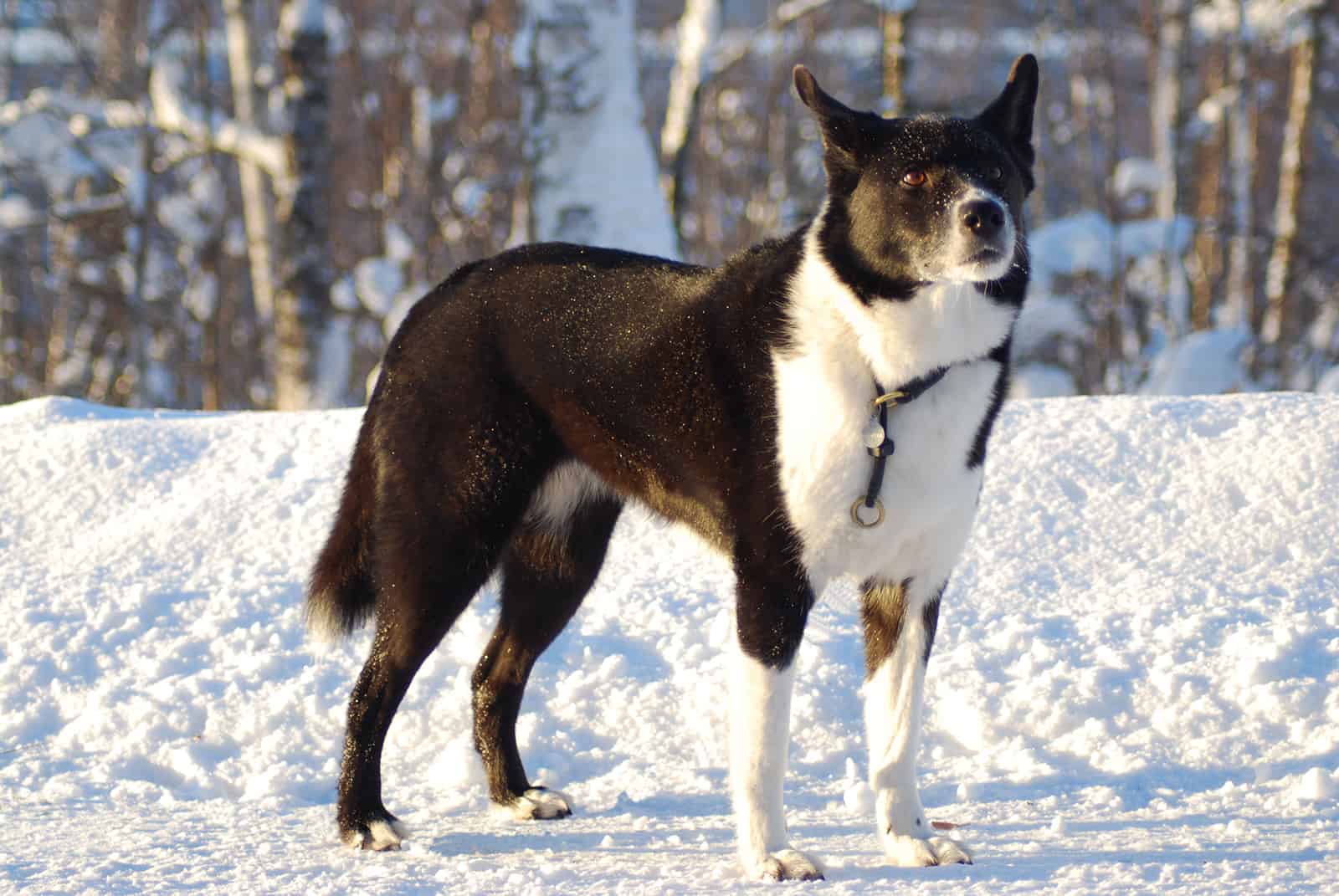
Background story
Usually, hunting dogs are focused mostly on chasing down small to medium prey animals. But, when you live in Russia, hunting bears seems pretty normal.
Well, at least it is normal for Karelian Bear Dogs. Don’t get these mixed up with Karelo-Finnish Laikas. They do come from the same region, but they’re not the same.
The Karelian Bear Dog became a separate dog breed back in 1946. This was around the same time that the breed standard was founded.
But, hunting bears was not their only occupation. They used to hunt other animals, like wolves or moose. The way they used to hunt bears was to find one and distract him with their barking so that the humans could fire at will.
What’s so curious about this Russian dog is that he did manage to leave the Russian area. The USA, Canada, and even Japan welcomed some examples of the breed.
Surprisingly, or not, Karelian Bear Dogs have proven themselves worthy in reducing the number of bear attacks, as well as keeping the endangered bears safe.
Appearance
The Karelian Bear Dog looks a lot like the Karelo-Finnish Laika. This has to be because of the dog breeds used in the process, since they all come from similar backgrounds.
This Bear Dog usually comes in black and white. This is a typical spitz dog, with a long muzzle, curved up tail, and pointy sharp ears.
The Karelian Bear Dog has a soft, dense coat, perfectly warm to keep them nice and cozy during long hunting trips.
Temperament
Sure, the Karelian Bear Dog is feisty, because you do need someone brave to go after a bear, but can he be a good companion too?
Well, if you socialize them the right way, Karelian Bear Dogs can be good pets. But, I would only recommend them to people with previous experience in handling mighty dogs.
27. Mongrel
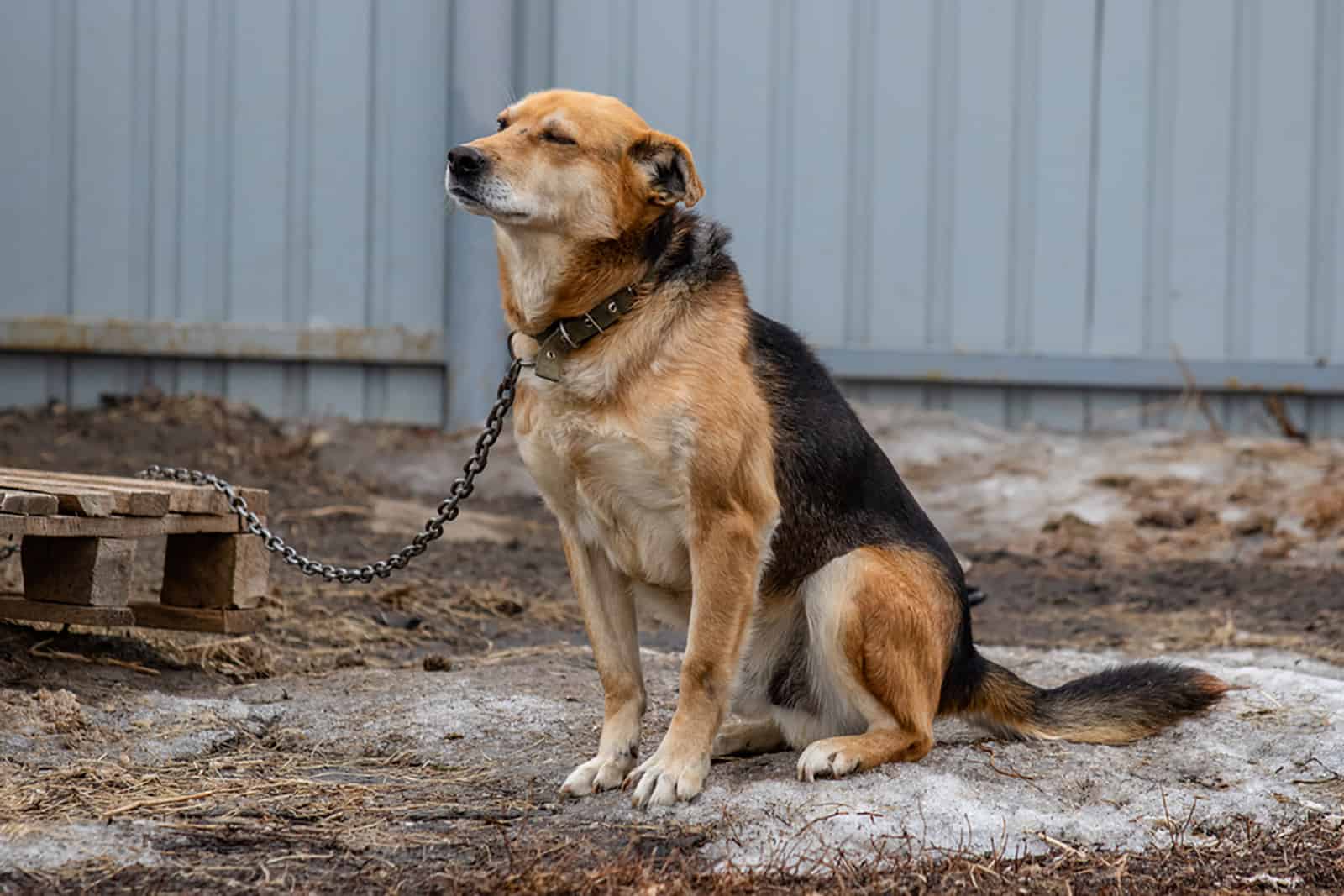
Lastly, I want to mention a dog that did a lot of promotion for all Russian dogs.
Technically, this isn’t a pure breed, but what kind of a list of Russian dogs would this be without the famous Laika?
Yes, we have had lots of different Laikas here today, but only one of them managed to go to space.
Sadly, the story of the Russian stray dog, Laika, is not a happy one. She was one of the many dogs used in the Soviet Space Program and simply a part of the animal testing.
Laika, or Kudryavka, or simply Curly, was presumably a mongrel of a Husky, Samoyed, and a Terrier. She was a small white dog with brown markings and a brown face mask.
And she was truly a hero that should not be forgotten.
Conclusion
When we talk about Russian dogs and the many breeds that were developed in this region, we can’t ignore one fact: Russia was a closed country for a long time.
Since the world was divided after the Cold War, there weren’t many streams that allowed the infiltration of foreign ideas and trends into the country.
In fact, it was strictly prohibited to own or speak about something that came from western countries, especially the USA. Just remember that good old book called Doctor Zhivago and for how long it was banned.
The constant pressure and race against the States in all fields, especially trips to outer space, made Russians extra competitive. They began inventing all sorts of things, and they even dabbled in dog breeding.
The result was many dogs which were equivalents to those already known to the rest of the world. For example, the Toy Russian Terrier is an obvious alternative to the Chihuahua.
Today, you saw numerous dog breeds that are either terrific workers, had powerful mighty paws, or are cuddly companions. What all these dogs have in common is that they’re completely adapted to the Russian way of living.
A lot of them can even take the cold, harsh temperatures in Siberia.
All in all, Russian dogs are truly pawmazing buddies that you should at least read about. A lot of them are too rare to be found and kept as pets, but that doesn’t make them any less perfect, right?
Read Next:
• 20 Chinese Dog Breeds—The Good, The Bad, And The Pugly
• 16 Dog Breeds That Whine A Lot: Still, We Love Them
